组蛋白乙酰化 去乙酰化 综述
组蛋白乙酰化酶和去乙酰化酶对心脏发育影响的研究进展
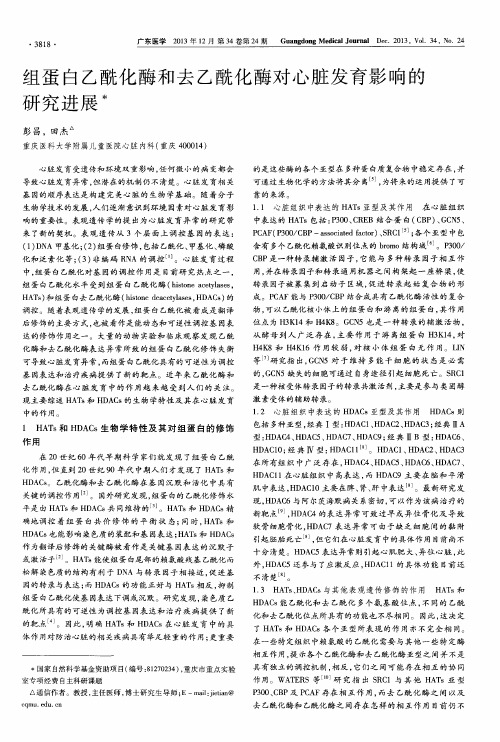
研究进展 木
彭 昌 ,田 杰
重 庆 医科 大 学 附属 儿 童 医 院心 脏 内科 ( 重庆 4 0 0 0 1 4 )
心脏发育受遗传和环境双重影响 , 任何微小的病 变都会
的是这些酶的各个亚型在 多种蛋 白质复合 物 中稳定存 在 , 并 可通过生物化 学的方 法将其分 离[ s J , 为将来的运用提供 了可 靠的来 源。 1 . 1 心脏 组织 中表 达的 H A T s 亚型及 其作 用 在 心脏组 织 中表达的 H A T s包括 : P 3 0 0 、 C R E B结合蛋 白 ( C B P ) 、 G C N 5 、 P C A F ( P 3 0 0 / C B P— a s s o c i a t e d f a c t o r ) 、 S R C 1 ; 各 个亚型 中包 含有 多个 乙酰化赖氨 酸识 别位 点的 b r o m o结 构域 。P 3 0 0 /
型: HD A C 4 、 H D A C 5 、 H D A C 7 、 H D A C 9 ; 经 典 ⅡB 型 : H D A C 6 、
H D A C 1 0 ; 经典 Ⅳ型: H D A C 1 1 。 HD A C 1 、 HD A C 2 、 HD A C 3
组蛋白乙酰化去乙酰化在神经病理性疼痛中的作用机制要点
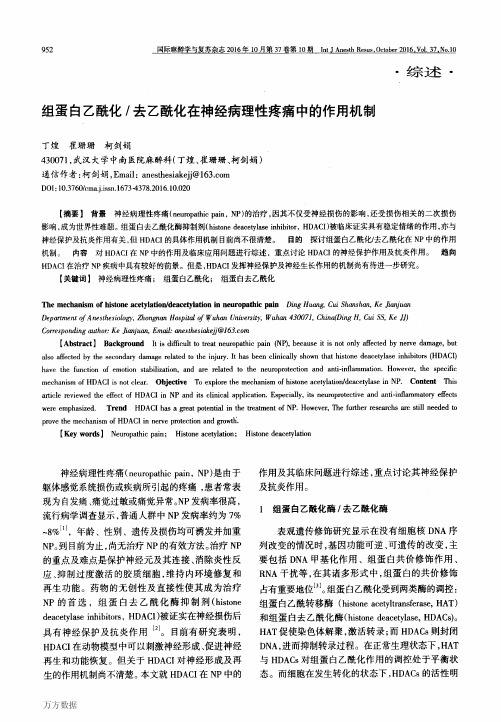
mechanism of HDACI is not
clear.Objective
To explore the mechanism of histone acetylation/deaeetylase in NP.Content
article reviewed the effect of HDACI in NP and its clinical application.Especially,its neuroprotective and anti・inflammatory effects
neurotrophic derived
HDACI抗炎作用 HDACI具有抗炎作用。在神经损伤后,HDACI
降低基质金属蛋白酶9的激活及表达,抑制炎性介 质(TNF.Ct、IL.p、IL-6)的产生,上调神经保护因子 (HSP70、HSP27和pAkt),下调凋亡相关因子p53, 从而保护神经元细胞及少突胶质细胞,减少神经损 伤面积,促进功能恢复‘12-13 J。HDACI的抗炎及抗神 经毒性作用依赖于小胶质细胞的凋亡Ⅲ1。在神经损 伤后,HDACI促进小胶质细胞的死亡,减少因小胶 质细胞过度激活引起的促炎因子的释放,进而降低 炎性反应Ⅲ。。在神经损伤后给予HDACI可有效降 低P2X4受体、ATP受体的表达及小胶质细胞的激 活、细胞因子释放u驯。这种作用是通过MAPK中 p38信号通路作用的。此外,HDACI可时间及浓度 依赖性地保护多巴胺能神经元免受脂多糖或肺炎 支原体细胞表面Pl蛋白诱导的神经毒性影响,诱 发小胶质细胞凋亡及抑制小胶质细胞炎性因子的 释放。综上所述,HDACI可促进小胶质细胞死亡,降 低细胞毒性反应,减少炎症反应。
神经保护及抗炎作用有关,但HDACI的具体作用机制目前尚不很清楚。 机制。
组蛋白去乙酰化酶研究进展
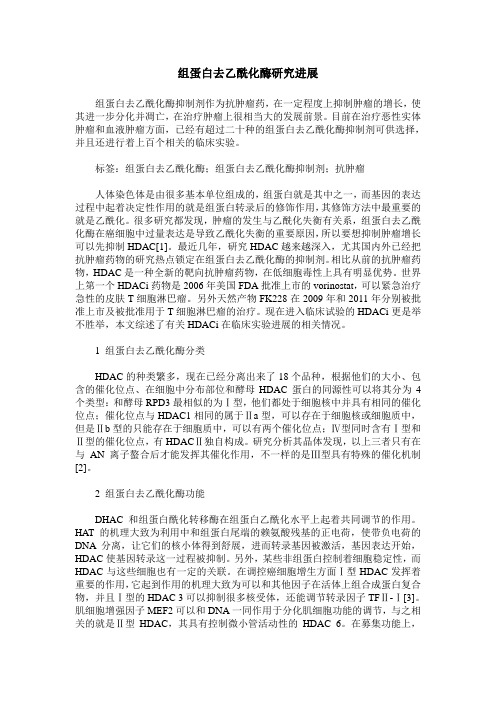
组蛋白去乙酰化酶研究进展组蛋白去乙酰化酶抑制剂作为抗肿瘤药,在一定程度上抑制肿瘤的增长,使其进一步分化并凋亡,在治疗肿瘤上很相当大的发展前景。
目前在治疗恶性实体肿瘤和血液肿瘤方面,已经有超过二十种的组蛋白去乙酰化酶抑制剂可供选择,并且还进行着上百个相关的临床实验。
标签:组蛋白去乙酰化酶;组蛋白去乙酰化酶抑制剂;抗肿瘤人体染色体是由很多基本单位组成的,组蛋白就是其中之一,而基因的表达过程中起着决定性作用的就是组蛋白转录后的修饰作用,其修饰方法中最重要的就是乙酰化。
很多研究都发现,肿瘤的发生与乙酰化失衡有关系,组蛋白去乙酰化酶在癌细胞中过量表达是导致乙酰化失衡的重要原因,所以要想抑制肿瘤增长可以先抑制HDAC[1]。
最近几年,研究HDAC越来越深入,尤其国内外已经把抗肿瘤药物的研究热点锁定在组蛋白去乙酰化酶的抑制剂。
相比从前的抗肿瘤药物,HDAC是一种全新的靶向抗肿瘤药物,在低细胞毒性上具有明显优势。
世界上第一个HDACi药物是2006年美国FDA批准上市的vorinostat,可以紧急治疗急性的皮肤T细胞淋巴瘤。
另外天然产物FK228在2009年和2011年分别被批准上市及被批准用于T细胞淋巴瘤的治疗。
现在进入临床试验的HDACi更是举不胜举,本文综述了有关HDACi在临床实验进展的相关情况。
1 组蛋白去乙酰化酶分类HDAC的种类繁多,现在已经分离出来了18个品种,根据他们的大小、包含的催化位点、在细胞中分布部位和酵母HDAC蛋白的同源性可以将其分为4个类型:和酵母RPD3最相似的为Ⅰ型,他们都处于细胞核中并具有相同的催化位点;催化位点与HDAC1相同的属于Ⅱa型,可以存在于细胞核或细胞质中,但是Ⅱb型的只能存在于细胞质中,可以有两个催化位点;Ⅳ型同时含有Ⅰ型和Ⅱ型的催化位点,有HDACⅡ独自构成。
研究分析其晶体发现,以上三者只有在与AN离子螯合后才能发挥其催化作用,不一样的是Ⅲ型具有特殊的催化机制[2]。
组蛋白修饰及其功能(乙酰化,甲基化,磷酸化等)-于凯讲解学习

表观遗传学(epigentics)是研究不改变DNA序列而由于其外 部修饰引起的基因开放与否的学科,涉及的主要机制有DNA甲基 化、组蛋白修饰、基因印记、RNA干扰等。其中研究得最多是 DNA甲基化和组蛋白乙酰化、组蛋白甲基化,这些修饰与活化或 失活染色质的结构形成相关。
染色质是由许多核小体组成的,大部分真核生物中有5种富含 碱性氨基酸的组蛋白,即H1,H2A,H2B,H3和H4。H2A,H2B, H3和H4各2个分子构成的8聚体是核小体的核心部分,H1的作用是 与线形 DNA结合以帮助后者形成高级结构。
组蛋白翻译完成后,其氨基尾巴会发生多种共价修饰,如乙 酰化、甲基化、磷酸化,泛素化和ADP核糖基化等,这些修饰都 是可逆性修饰,这些修饰共同构成了“组蛋白密码”。
1. 组蛋白乙酰化
核心组蛋白乙酰化反应多发生在核心组蛋白 N端碱性氨基 酸集中区的特定 Lys 残基。组蛋白乙酰化由组蛋白乙酰转移酶 (histone acetyltransferase,HAT)和组蛋白去乙酰化酶(histone deacetylase,HDAC)协调进行。HAT通过将乙酰辅酶 A 的乙酰 基转移到 Lys 的NH+,中和掉一个正电荷。 HDAC使组蛋白去乙 酰化,与带负电荷的DNA紧密结合,染色质致密卷曲,基因的 转录受到抑制。
2. 组蛋白的甲基化
组蛋白甲基化是由组蛋白甲基化转移酶(histone methyl transferase,HMT)完成的。甲基化可发生在组 蛋白的赖氨酸和精氨酸残基上,而且赖氨酸残基能够 发生单、双、三甲基化,而精氨酸残基能够单、双甲 基化,这些不同程度的甲基化极大地增加了组蛋白修 饰和调节基因表达的复杂性。
局部乙酰化举例
当DNA与核小体尚未解开缠绕时,转录激活因子如糖皮质激素受体可以和DNA上相应 的反应元件(GRE)结合。当结合至GRE之后,糖皮质激素募集共激活因子如CBP到染色 体上的靶转录基因区。此时,共激活因子利用HAT活性使得结合在DNA启动子区域的核心 组蛋白乙酰化,进而使DNA与组蛋白结合减弱,核小体释放,转录因子和RNA聚合酶可以 与DNA上特异的启动子结合,启动靶基因的转录。
组蛋白去乙酰化酶的研究进展

组蛋白去乙酰化酶的研究进展组蛋白去乙酰化酶(HDACs)是一类重要的酶类蛋白质,在细胞核内对染色质修饰起着重要的作用,调节基因的表达。
在过去的几十年中,对HDACs的研究取得了重大进展,深化了人们对这些蛋白质的认知和理解。
一、HDACs的分类HDACs主要分为四类:I、II、III和IV类。
其中I、II类又分为A、B、C、D子型。
这四类HDACs在受体结构及功能上都有所不同。
从结构上来看,HDACs主要由三个结构域组成,包括一个催化结构域、一个辅酶A结合结构域和一个维持结构稳定的结构域。
二、HDACs的生物学功能HDACs主要通过催化组蛋白的去乙酰化反应来调节基因的表达。
在生物体内,组蛋白去乙酰化是一个非常关键的生物过程,能够帮助细胞调节基因转录的水平,从而影响细胞的生长、分化、凋亡和代谢等生物过程。
HDACs通过去掉组蛋白的乙酰基,使其变得更加紧密结合,从而抑制相应的基因表达。
三、HDACs在疾病治疗上的应用近年来,越来越多的研究表明,在很多重要的疾病中,包括癌症、炎症和神经系统疾病等,HDACs扮演着非常重要的角色。
特别是在抗癌治疗方面,HDACs已经成为了一个非常重要的领域。
很多针对HDACs的抗癌药物,如美罗华(Merck)、法诺司汀(Novartis)等,已经被广泛使用,并取得了很好的治疗效果。
四、HDACs与DNA甲基化的关系HDACs在细胞内还与DNA甲基化过程密切相关。
DNA甲基化是一种常见的表观修饰形式,在基因表达、DNA复制和细胞分化等生物过程中起着非常重要的作用。
通过调节HDACs的表达和活性,可以进一步影响细胞内DNA甲基化修饰,从而调节基因的表达。
总结起来,HDACs是一类非常重要的酶类蛋白质,对于细胞核内染色质修饰和基因转录调节起着重要的作用。
在细胞内,通过调节HDACs的表达和活性,可以进一步影响基因的表达和细胞的生物过程,具有广泛的研究和应用前景。
组蛋白去乙酰化酶(HDACs)的研究进展

组蛋白去乙酰化酶(HDACs)的研究进展【摘要】在肿瘤的表观遗传学研究中,组蛋白的乙酰化修饰对肿瘤的发生发展起重要作用。
正常细胞体一旦出现核内组蛋白乙酰化与去乙酰化的失衡,即会导致正常的细胞周期与细胞代谢行为的改变而诱发肿瘤。
组蛋白去乙酰化酶(histone deacetylases,HDACs)催化组蛋白的去乙酰化,维系组蛋白乙酰化与去乙酰化的平衡状态,与癌相关基因转录表达、细胞增殖分化及细胞凋亡等诸多过程密切相关。
从组蛋白去乙酰化酶HDACs的结构分类及其与肿瘤发生发展关系两方面对HDACs做一综述。
【关键词】组蛋白去乙酰化酶(HDACs);肿瘤;表观遗传学Abstract:The modification for histone acetylation is of great importance for formulation and development oftumors in the epigenetic study of tumors. The disequilibrium of histone acetylation and deacetylation may cause some changes of cell cycle and cell metabolism. Histone deacetylases (HDACs) catalyze the deacetylation of histones,and maintain the equilibrium between histone acetylation and deacetylation as well. They are related to many regulation processes containing transcription of oncogene,cell cycle,apoptosis and so on. The structure classification of HDACs and the relationship between the HDACs and the formation and advancement of tumor were reviewed in this paper.Key words:histone feacetylases (HDACs); tumor; epigenetics肿瘤的发生是一个复杂的病理过程,受多重因素的影响,包括个体遗传因素、环境因素、物理化学因素、分子生物学因素等等。
说明组蛋白乙酰化和去乙酰化影响基因转录的机制

说明组蛋白乙酰化和去乙酰化影响基因转录
的机制
组蛋白乙酰化和去乙酰化是两种基本的表观遗传学调控方式,可以影响基因的转录活性,从而决定生物的发育和生命过程。
组蛋白是核小体中的主要蛋白质,而核小体是染色体基本单位的组成部分。
组蛋白可以被翻译修饰,其中包括乙酰化和去乙酰化。
乙酰化增加了组蛋白的乙酰基(醋酸基)含量,从而使组蛋白的阳离子性减少,DNA与组蛋白的结合力减弱,导致染色体更加松散,更容易读取DNA上的基因序列,因此可以促进基因转录。
而去乙酰化则有相反的作用,可以增加组蛋白阳离子性,增强DNA与组蛋白的结合力,使染色体更加紧密,阻碍基因转录。
组蛋白乙酰化和去乙酰化通常通过两种方式发挥作用。
一种是直接作用于转录因子,乙酰化使这些转录因子更容易与DNA结合,同时降低了转录因子与组蛋白之间的相互作用力,从而促进基因转录。
而去乙酰化则有相反的作用,可以阻碍转录因子与DNA的结合,导致基因转录受阻。
另一种方式是通过影响染色质结构来发挥作用。
乙酰化可以直接降低组蛋白和组蛋白之间的相互作用力,从而使染色体更加松散,容易转录。
去乙酰化则可以更加稳定染色体结构,从而阻碍转录因子的结合和基因的转录。
总之,组蛋白乙酰化和去乙酰化是控制基因转录的重要机制。
不同类型的细胞和生物在基因调控方面都存在着独特的表观遗传学调控
机制,而组蛋白乙酰化和去乙酰化则是其中的重要代表。
对于研究基因转录调控及其表观遗传学机制,深入了解组蛋白乙酰化和去乙酰化作用机理是非常必要的。
同时,通过在实验室中甄别组蛋白乙酰化和去乙酰化酶的活性、开发相关的抑制剂和激动剂等措施,也有助于治疗一些基因和表观表达异常相关的疾病。
组蛋白去乙酰化酶的研究进展

例如,在阿尔茨海默病患者脑组织中,HDAC2的表达上调与β-淀粉样蛋白的 沉积密切相关。
3、HDAC的调控机制
HDAC的调控机制主要包括转录水平和翻译后修饰水平上的调控。在转录水平 上,一些转录因子如SP1、SP3和E2F等可以与HDAC的启动子区域结合,促进HDAC 的转录和表达。在翻译后修饰水平上,HDAC可以被磷酸化、泛素化等修饰,从而 影响其活性和稳定性。例如,磷酸化修饰可以抑制HDAC的活性,而泛素化修饰可 以促进HDAC的降解。
2、诱导凋亡研究:通过检测细胞凋亡相关指标,如Caspase-3活性、Bcl-2 蛋白等,分析新型抑制剂对肿瘤细胞凋亡的诱导作用。
3、细胞周期研究:通过细胞周期相关指标,如DNA含量、细胞分裂等,探讨 新型抑制剂对肿瘤细胞周期的影响。
4、耐药性研究:针对具有耐药性的肿瘤细胞,研究新型抑制剂的耐药性克 服能力。
因此,针对HDAC的研究已经成为生物医学领域的一个热点。本次演示将综述 HDAC的研究历程、最新进展、药物开发等方面,以期为相关领域的研究者提供参 考。
历史回顾
HDAC的研究可以追溯到20世纪60年代,当时科学家们发现了组蛋白乙酰化酶 和去乙酰化酶的存在。然而,在接下来的几十年中,HDAC的研究进展缓慢,人们 对它的生物学功能知之甚少。直到20世纪90年代末,随着基因组学和蛋白质组学 技术的发展,HDAC的研究才取得了突破性进展。研究发现,HDAC在多种细胞信号 转导通路中发挥关键作用,并且与多种疾病的发生密切相关。
组蛋白去乙酰化酶的研究进展
01 引言
03 研究进展 05 展望
目录
02 历史回顾 04 药物开发 06 参考内容
引言
组蛋白去乙酰化酶(HDAC)是一类在细胞内发挥重要作用的酶,它参与调节 基因表达和细胞命运。HDAC在许多生物学过程中发挥关键作用,包括细胞分化、 细胞周期调控、DNA修复和细胞死亡等。近年来,随着对HDAC的深入研究发现, 其在多种疾病的发生和发展中发挥重要作用,如癌症、神经退行性疾病和免疫疾 病等。
组蛋白乙酰化的研究进展_童汪霞

肿瘤基础与临床 2008年 12月第 21 卷第 6期
是非常 重要 的。用 荧光 素酶 测定, 精氨 酸 替代 L ys378, 就减少了 GAL 4-Sm ad3c的转 录活性。这 些结果 均表明, p300 /CBP 乙 酰 化 Sm ad3 可 能 调 节 其 转 录 活性 [ 3] 。 1. 3 A CTR ACTR 是由 L ou ie等 [ 4] 发现的一个具有 HAT 活性的核受体共激活子。它有多 个与核受体相 互作用 的功 能 域, 并 能 独立 的 分 别与 p300 /CBP 和 PCAF 相互作用, 增强核受体的转录激活功能。ACTR 既可乙酰化游离组蛋白 H 2B、H 3和 H 4, 也可乙酰化核 小体中的 H 3和 H 4。它与上述的 HAT 无同源性, 是一 种新的 HAT。 1. 4 Rtt109-Vps75复合物 Rtt109是基本的 HAT, 主 要在芽酵母中负责 H 3-K 56的乙酰化。组蛋白 H 3上 的赖氨酸 56( H 3-K56) 的乙酰化发生 在 DNA 合成期 ( S期 ), 而在细胞周期的 G2 /M 期则消失。 R tt109 和 Vps75形成一种复合 物, 来乙酰 化 H 3 /H 4 /H 2A /H 2B 核心组蛋白中的 H 3, 而对核小体上的 H 3却无效。重 组体和天然的 Rtt109-Vps75复合物均显示对于核小体 H 3并无可 检出活 性, 故 可推 测在 细胞 周期 的 G2 /M 期, R tt109-Vps75复合物并不能乙酰化核小体 H 3, 而 H 3-K56的乙酰化过程只是部分由其介导。实验证明, Rtt109-Vps75复合物当 H 3 积聚在核小体时显示无法 检测出活性, 在有 活性的基因中能检测到 H 3-K56 的 乙酰化, 故 H 3-K 56乙酰化定位于活性基因上, 可能反 应了 S期这种 H 3的修饰形态沉积于染色质上。换句 话说, 这种修饰也可能包括在转录过程中, 用新合成的 乙酰化 H 3在赖氨酸 56上替换受损的组蛋白 [ 5] 。
组蛋白去乙酰化酶(HDACs)的研究进展

Ke o d :io efae lss( D C ) u o ; pgn t s yw r shs n ct ae H A s ;tm r e i e c t e y e i
an i opl s i ge tne a tc a n ̄
XI Jn F A ig, ENG Big h n n —o g
( colfP am c G ag ogP am cui l o ee G a ghu G ag og5 0 0 C ia Sh o o h r ay,u n d n h r aet a lg , u nzo , u n d n 10 6,hn ) c C l
广 东 药 学 院 学 报
Jun lfG ag ogP am cu cl o ee o ra o u nd n hr aeta lg i Cl
组 蛋 白去 乙酰化 酶 ( D C ) H A s 的研 究进 展
夏靖 , 冯冰虹
( 广东 药学 院 药 科 学 院 广 东 广 州 5 00 ) 10 6
蛋 白去 乙酰化酶 H A s D C 的结构分类及其与肿瘤 发生发展关系两方面对 H A s D C 做一综述。 关键词 : 组蛋 白去乙酰化酶 ( D C ) 肿瘤 ; H A s; 表观遗传学
中 图分 类号 : 3 Q7 6 文 献标 识 码 : d i1 .99 ji n 10 8 8 .0 0 0 .2 R7 ; 8 A o:03 6/.s .0 6— 7 3 2 1.5 0 8 s
组蛋白的乙酰化

百泰派克生物科技
组蛋白的乙酰化
组蛋白是真核生物染色质中的一种碱性蛋白质,可与DNA双螺旋形成DNA-组蛋白
复合物。
在不同的组蛋白酶作用下,组蛋白会发生不同的修饰,如甲基化、乙酰化、磷酸化和泛素化等。
组蛋白修饰在一定程度上会导致转录激活或基因沉默,从而调控基因表达,影响免疫系统和免疫反应,甚至导致肿瘤等疾病的发生。
在乙酰化转移酶(HAT)的作用下,组蛋白的N端碱性氨基酸集中区的特定赖氨酸
残基可以共价结合乙酰基发生乙酰化修饰,从而激活转录反应;乙酰化修饰与磷酸化修饰一样,是可逆的修饰过程,在组蛋白去乙酰化酶(HDAC)催化下,组蛋白能发生去乙酰化,抑制基因表达。
百泰派克生物科技采用Thermo Fisher的Q ExactiveHF质谱平台结合Nano-LC,
提供组蛋白翻译后修饰分析服务技术包裹,可对各种组蛋白修饰如乙酰化、甲基化、泛素化、磷酸化和ADP核糖基化等进行定性和定量鉴定,还可根据需求提供定制化的检测方案,欢迎免费咨询。
组蛋白去乙酰化酶在呼吸道相关疾病中的作用及展望

组蛋白去乙酰化酶在呼吸道相关疾病中的作用及展望陈黛诗;柯朝阳;陈雷【摘要】组蛋白去乙酰化酶(HDAC)在生物体中广泛表达,是许多生理过程的关键酶,参与细胞的各种重要活动,包括染色质重塑、蛋白转录调节、细胞周期、衰老、氧化应激、炎症和免疫基因的表达等.研究表明,组蛋白乙酰化和去乙酰化平衡状态与呼吸道炎性相关疾病的发生发展密切相关,其表达失衡可导致炎症基因的表达及氧化应激的发生.本文从HDAC的结构分类及其与呼吸道相关炎性疾病发生发展的关系这两方面进行综述.%Histone deacetylases (HDAC) are pivotal enzymes in many physiological processes widely expressed in almost all tissues including chromatin remodeling,regulation of protein transcription,cell cycle,aging,oxidative stress,inflammation and expression of immune genes.Recent studies indicated that the equilibrium state of histone acetylation and deacetylation is closely related to respiratory tract inflammation,and the unbalanced expression of HDAC could induce the expression of genes related to the inflammatory cytokines and oxidative stress.Now the structure and classification of HDAC and the updated results on HDAC in the inflammatory respiratory diseases are herewith reviewed in present paper.【期刊名称】《解放军医学杂志》【年(卷),期】2017(042)011【总页数】6页(P962-967)【关键词】组蛋白去乙酰化酶;慢性鼻窦炎;变应性鼻炎;慢性阻塞性肺疾病;哮喘【作者】陈黛诗;柯朝阳;陈雷【作者单位】100853北京解放军总医院耳鼻咽喉头颈外科;518020深圳深圳市人民医院耳鼻咽喉头颈外科、暨南大学附属第二临床医学院;518020深圳深圳市人民医院耳鼻咽喉头颈外科、暨南大学附属第二临床医学院;100853北京解放军总医院耳鼻咽喉头颈外科【正文语种】中文【中图分类】R765.4随着表观遗传学研究的深入,越来越多的学者认识到环境的改变可影响遗传,其中组蛋白修饰是表观遗传学的重要组成部分,研究发现组蛋白去乙酰化酶(histone deacetylase,HDAC)参与了多种疾病的发生发展过程,包括炎性疾病、代谢紊乱、衰老和肿瘤等[1-5]。
组蛋白乙酰化_去乙酰化与基因表达调控
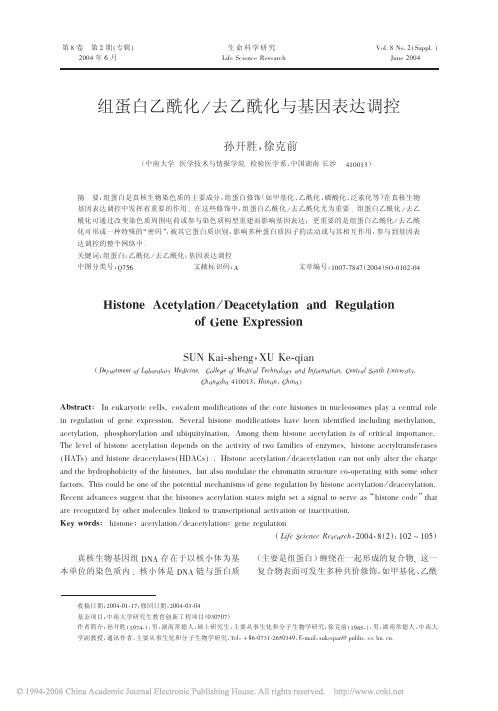
( 人 类 包 括 (&)、 簇 、 %&’% 家 簇 *+,) - ’,()、 、 它们能利用 +56 *,.(+, 等 ) /01$ - 23(4 家簇, 水解产生的能量使染色质构型改变或核小体滑动7 “组蛋白尾巴” 另一类就是参与 修饰的酶类, 主要 是 使 组 蛋 白 乙 酰 化 - 去 乙 酰 化 的 酶 (.+58 和 .4+,8)7 .+58 使组蛋白尾巴乙酰化,形成“开 放” 的染色质结构, 便于转录进行; 相反, .4+,8 “封闭” 使组蛋白去乙酰后, 染色质形成 结构, 导致
摘Байду номын сангаас
(如甲基化、 要: 组蛋白是真核生物染色质的主要成分, 组蛋白修饰 乙酰化、 磷酸化、 泛素化等 ) 在真核生物
基因表达调控中发挥着重要的作用 % 在这些修饰中, 组蛋白乙酰化 & 去乙酰化尤为重要 % 组蛋白乙酰化 & 去乙 酰化可通过改变染色质周围电荷或参与染色质构型重建而影响基因表达;更重要的是组蛋白乙酰化 & 去乙酰 “密码 ” 化可形成一种特殊的 , 被其它蛋白质识别, 影响多种蛋白质因子的活动或与其相互作用, 参与到基因表 达调控的整个网络中 % 关键词: 组蛋白; 乙酰化 & 去乙酰化; 基因表达调控 中图分类号: ’()* 文献标识码: + 文章编号: !""(,(-$( . #""$ / 01,"!"#,"$
!
参与组蛋白乙酰化和去乙酰化的酶
组蛋白的乙酰化和去乙酰化是一个动态的可
逆过程, 两类重要的酶催化并调控这一过程: 组蛋 白乙酰转移酶(,-./012 &32/45/671.8267.2.,,&9.) 和 组 蛋 白 去 乙 酰 化 酶 (,-./012 ’2732/457.2., ,’&:.)* ,&9. 的主要功能是将乙酰辅 & 的乙酰 基转移到组蛋白的赖氨酸残基上 * 根据 ,&9. 的 来源和功能将其分为两类: 主 & 型位于细胞核内, 要乙酰化核小体组蛋白, 也可使非组蛋白乙酰化; 可使新合成的组蛋白乙酰化, ; 型存在于细胞质, 因而对基因表达调控起重要作用的主要是 & 型 ,&9.* 研究发现,许多转录辅激活因子具有内源 性的 & 型 ,&9. 活性 * 目前已被鉴定的 ,&9. 有 $" 多 种 ,主 要 为 如 下 几 个 家 族 :<=&9 (<31>)6257/2? =)732/45/671.8267.2.) 家族, 其主要成 员有 <31> 、 ( % :&@、 A5B# 、 ,7/! 、 ,B7$ 等; CDE9 家 族, 成 员 主 要 为 CFG、 DH8$ % E7.# 、 E7.$ 和 9-B; 另外还有一些转录因子, 如 (#"" % :;( 家 族 ; J!K 核受体辅激活物, 如 &9:I、 9&@! $>"; EI:!等 * 后来相继在 ,’&:. 最初在酿酒酵母中发现, 不同的生物中发现多种 ,’&:.* 至今已发现的人 类 ,’&:. 有 !L 种,根据其与酿酒酵母的 # 种 (4I(’#、 的同源性分为 # 和 4E-6$) ,’&:. 4,’&!、 类 * 第" 类与 4I(’# 同源, 包括 ,’&:!、 ,’&:$、 类与 4,’&! 同 ,’&:#、,’&:L、,’&:!!;第 ! 源 , 包 括 ,’&:M、 ,’&:>、 ,’&:+、 ,’&:N、 第 # 类与 4E-6$ 同源, 已在人细 ,’&:O、 ,’&:!"; #K 分别为 EPI9! Q N J $ , 胞中鉴定出 N 种, *
组蛋白乙酰化/去乙酰化与肺部疾病
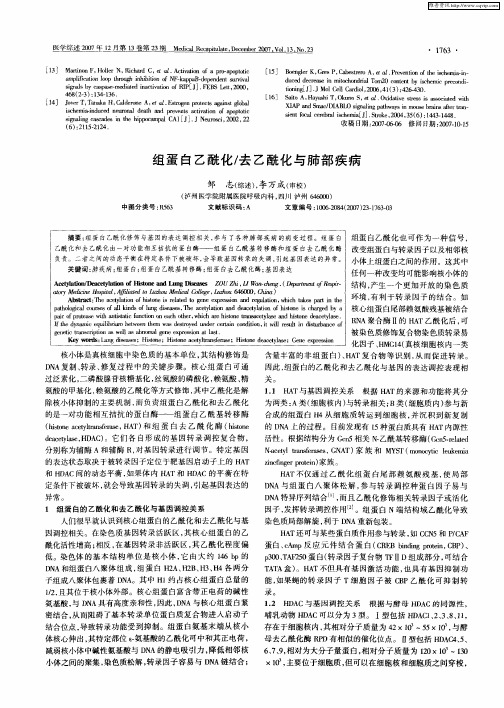
:e…stre…ss is asst ̄i wil}l
XIAP and S mac/DI’ABLO ’alingpathw…
sign
aysin m【】use ns 岫
s…ien…t …al cerebral isbcl收 Jhlle ̄稿mlllilaB日[k期J, ]]J.“ ̄ tro…Ke , ~, -o6 ’D修D\回 O)日:l期 q'q'D- lq' q' ̄ . …
1I田 H 棚 : :2‘0wo 70^6H f多 }H|“ 删 : :2z0w∞,. 。1i o.1 i5 ]
组 蛋 白乙酰化/去 乙酰化 与肺 部 疾病
邹 志(综述),李万成 (审校)
(泸州医学 院附属 医院呼吸内科 ,四川 泸州 646OOO)
中 图分 类 号 :R563
文献 标 识 码 :A
.
duced dectease in mitochondrial Toni20 content by ischemic Drecondi—
tioning[J]. J M01 Cell Cardio1,20O6,41(3):426_43o.
[16] Sait。
ay
T,Okuno s,’et o1.’O
signals by caspase.mediated inactiVation of RIP[J].FEBS Lett,2OO0,
【l4] 4 68(2-3):134-136.
]
T,Tanaka H,Caldero ne . a/ Estrogen protects agai. nst global
被染 色质修饰复合物染色质转录易 化 因子 、HMG14(真 核 细 胞 核 内一 类
组蛋白乙酰化酶及去乙酰化酶与肺部疾病
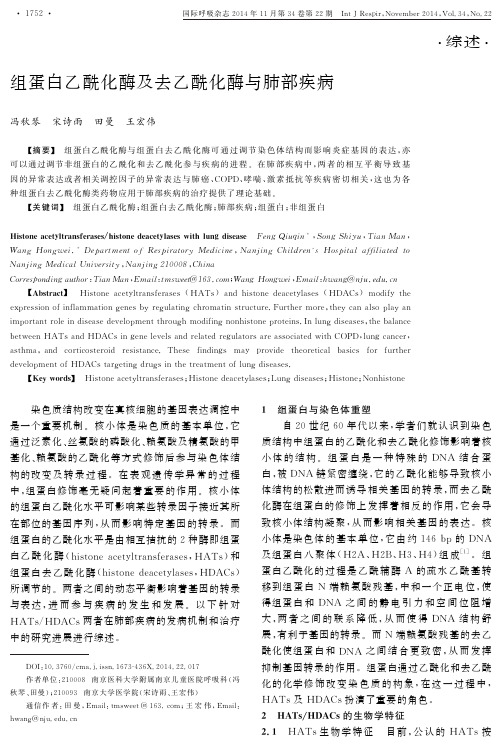
㊃综述㊃D O I :10.3760/c m a .j.i s s n .1673-436X.2014.22.017作者单位:210008南京医科大学附属南京儿童医院呼吸科(冯秋琴㊁田曼);210093南京大学医学院(宋诗雨㊁王宏伟)通信作者:田曼,E m a i l :t m s w e e t @163.c o m ;王宏伟,E m a i l:h w a n g @n ju .e d u .c n 组蛋白乙酰化酶及去乙酰化酶与肺部疾病冯秋琴 宋诗雨 田曼 王宏伟ʌ摘要ɔ 组蛋白乙酰化酶与组蛋白去乙酰化酶可通过调节染色体结构而影响炎症基因的表达,亦可以通过调节非组蛋白的乙酰化和去乙酰化参与疾病的进程㊂在肺部疾病中,两者的相互平衡导致基因的异常表达或者相关调控因子的异常表达与肺癌㊁C O P D ㊁哮喘㊁激素抵抗等疾病密切相关,这也为各种组蛋白去乙酰化酶类药物应用于肺部疾病的治疗提供了理论基础㊂ʌ关键词ɔ 组蛋白乙酰化酶;组蛋白去乙酰化酶;肺部疾病;组蛋白;非组蛋白H i s t o n e a c e t y l t r a n s f e r a s e s /h i s t o n e d e a c e t y l a s e sw i t h l u n g di s e a s e F e n g Q i u q i n *,S o n g S h i y u ,T i a nM a n ,W a n g H o n g w e i .*D e p a r t m e n to f R e s p i r a t o r y M e d i c i n e ,N a n j i n g C h i l d r e n 's H o s p i t a la f fi l i a t e dt o N a n j i n g M e d i c a lU n i v e r s i t y ,N a n j i n g 210008,C h i n a C o r r e s p o n d i n g a u t h o r :T i a nM a n ,E m a i l :t m s w e e t @163.c o m ;W a n g H o n g w e i ,E m a i l :h w a n g @n ju .e d u .c n ʌA b s t r a c t ɔ H i s t o n ea c e t y l t r a n s f e r a s e s (HA T s )a n dh i s t o n ed e a c e t y l a s e s (H D A C s )m o d i f y th e e x p r e s s i o no f i n f l a mm a t i o n g e n e sb y r e g u l a t i n g c h r o m a t i ns t r u c t u r e .F u r t h e rm o r e ,t h e y c a na l s o p l a y an i m p o r t a n t r o l e i nd i s e a s e d e v e l o p m e n t t h r o u g hm o d i f i n g n o n h i s t o n e p r o t e i n s .I n l u n g di s e a s e s ,t h eb a l a n c e b e t w e e nHA T s a n dH D A C s i n g e n e l e v e l s a n d r e l a t e d r e g u l a t o r s a r e a s s o c i a t e dw i t hC O P D ,l u n g ca n c e r ,a s t h m a ,a n d c o r t i c o s t e r o i d r e s i s t a n c e .T h e s e f i n d i n g s m a y p r o v i d e t h e o r e t i c a lb a s ic s f o r f u r t h e rde v e l o p m e n t o fH D A C s t a r g e t i n g d r u g s i n t h e t r e a t m e n t of l u ng di s e a s e s .ʌK e y wo r d s ɔ H i s t o n e a c e t y l t r a n s f e r a s e s ;H i s t o n e d e a c e t y l a s e s ;L u n g d i s e a s e s ;H i s t o n e ;N o n h i s t o n e 染色质结构改变在真核细胞的基因表达调控中是一个重要机制㊂核小体是染色质的基本单位,它通过泛素化㊁丝氨酸的磷酸化㊁赖氨酸及精氨酸的甲基化㊁赖氨酸的乙酰化等方式修饰后参与染色体结构的改变及转录过程㊂在表观遗传学异常的过程中,组蛋白修饰毫无疑问起着重要的作用㊂核小体的组蛋白乙酰化水平可影响某些转录因子接近其所在部位的基因序列,从而影响特定基因的转录㊂而组蛋白的乙酰化水平是由相互拮抗的2种酶即组蛋白乙酰化酶(h i s t o n ea c e t y l t r a n s f e r a s e s ,HA T s )和组蛋白去乙酰化酶(h i s t o n ed e a c e t yl a s e s ,H D A C s )所调节的㊂两者之间的动态平衡影响着基因的转录与表达,进而参与疾病的发生和发展㊂以下针对H A T s /H D A C s 两者在肺部疾病的发病机制和治疗中的研究进展进行综述㊂1 组蛋白与染色体重塑自20世纪60年代以来,学者们就认识到染色质结构中组蛋白的乙酰化和去乙酰化修饰影响着核小体的结构㊂组蛋白是一种特殊的D N A 结合蛋白,被D N A 链紧密缠绕,它的乙酰化能够导致核小体结构的松散进而诱导相关基因的转录,而去乙酰化酶在组蛋白的修饰上发挥着相反的作用,它会导致核小体结构凝聚,从而影响相关基因的表达㊂核小体是染色体的基本单位,它由约146b p 的DN A 及组蛋白八聚体(H 2A ㊁H 2B ㊁H 3㊁H 4)组成[1]㊂组蛋白乙酰化的过程是乙酰辅酶A 的疏水乙酰基转移到组蛋白N 端赖氨酸残基,中和一个正电位,使得组蛋白和D N A 之间的静电引力和空间位阻增大,两者之间的联系降低,从而使得D N A 结构舒展,有利于基因的转录㊂而N 端赖氨酸残基的去乙酰化使组蛋白和D N A 之间结合更致密,从而发挥抑制基因转录的作用㊂组蛋白通过乙酰化和去乙酰化的化学修饰改变染色质的构象,在这一过程中,H A T s 及H D A C s 扮演了重要的角色㊂2 H A T s /H D A C s 的生物学特征2.1 H A T s 生物学特征 目前,公认的H A T s 按㊃2571㊃国际呼吸杂志2014年11月第34卷第22期 I n t JR e s pi r ,N o v e m b e r 2014,V o l .34,N o .22照源和功能分为6类:G N A T家族㊁p300/C B P㊁T A F1I p250㊁核受体共激活因子㊁MY S T家族(MO Z㊁Y b f2/S a s3㊁S a s2和T i p60)和T FⅢC㊂H A T s常以组蛋白为作用点,形成H A T s复合物,再对基因进行调节㊂H A T s使转录活化因子乙酰化,促使D N A与转录活化因子结合,进而促使组蛋白激酶活化,促进组蛋白的磷酸化,后转录因子募集H A T s,乙酰化修饰后的D N A结构松散,R N A聚合酶Ⅱ募集到特定位点进一步参与基因的转录过程㊂H A T s不仅有激活基因的能力,如在癌症中,它可激活癌症相关抑制基因,参与细胞凋亡过程;同时也具有基因抑制的能力,如果蝇的转录因子T细胞相关因子被乙酰化修饰后是抑制其表达的㊂2.2 H D A C s生物学特征基于酵母种系发育中的不同H D A C s的结构同源性分析,将真核生物的H D A C s分为4类:Ⅰ类H D A C s与酵母R p d3具有同源性,包括H D A C1㊁2㊁3和H A D C8;Ⅱ类H D A C s与酵母H d a1具有同源性,包括H D A C4㊁5㊁6㊁7㊁9及H D A C10;Ⅲ类H D A C s是沉默信息调节因子2及相关酶类(s i r t u i n s),其是烟酰胺腺嘌呤二核苷酸(N A D+)依赖的H D A C s类;Ⅳ类H D A C s 主要是H D A C11,它被独立划分为一类㊂H D A C s 各成员在细胞中的定位主要是存在于细胞核和细胞质中,少部分定位在细胞器如线粒体中㊂受H D A C s调控的蛋白种类很多,除了可以对组蛋白进行去乙酰化修饰,提高染色质结构稳定性从而抑制转录外,还可以调节如a微管蛋白㊁P53㊁P65及M y o d等非组蛋白的去乙酰化㊂另外,非典型的去乙酰化酶s i r t u i n s蛋白,可以对一些非组蛋白产生去乙酰化作用,参与单核细胞的程序性凋亡㊂其中一种由S I R T1编码的s i r t u i n s蛋白能使P53去乙酰化,下调P53介导的细胞凋亡,这和组蛋白去乙酰化酶抑制剂(H D A C i)药物目前研究用于治疗肿瘤类疾病是密切相关的[2]㊂在体外实验中,S I R T1编码的蛋白通过使P65去乙酰化从而使肺癌相关的细胞株凋亡,这为H D A C i用于肺癌的治疗提供了基础研究㊂3H A T s/H D A C s与肺部疾病3.1 H A T s/H D A C s与肺癌组蛋白的乙酰化水平和转录的活化是密切相关的㊂在肿瘤疾病中,组蛋白的乙酰化作用使得一些抑制肿瘤发生的沉默基因得以表达㊂染色质的结构中组蛋白的超乙酰化(活化)或去乙酰化(失活)可能和肿瘤的发生发展是密切相关的㊂有研究发现,特异性的H D A C i如T S A㊁丁酸苯酯㊁缩酚酸肽㊁S A H A或者M S-275在体外实验中可以诱导组蛋白的超乙酰化㊁细胞周期停滞及细胞凋亡㊂近期的研究发现D N A的甲基化和组蛋白的乙酰化过程都需要甲基结合相关蛋白㊂这些甲基化相关蛋白会通过识别甲基化的D N A从而抑制相关基因的转录[3]㊂它们也可能定位在去乙酰化酶的结构中,并在这些蛋白的基因沉默区发挥作用㊂在肺癌细胞中,D A C与丁酸苯酯联合应用会增强肿瘤相关沉默基因的高表达[2]㊂针对肿瘤细胞应用D A C及F R901228的联合应用会诱导细胞的凋亡,同时促进T细胞对肿瘤细胞的识别及杀灭㊂目前,针对这些药物应用于肺癌及胸膜肿瘤的一期临床研究已经在着手进行㊂针对H D A C i类药物可以抑制肝癌㊁肺癌㊁白血病等恶性肿瘤的生长㊁转移,并且可以促使癌细胞发生凋亡,学者们对它的抗癌机制进行了研究,提出了很多可能的作用机制,包括促凋亡㊁促分化㊁细胞周期阻滞㊁氧化应激㊁上调肿瘤抑制基因㊁下调相关生长因子㊁抑制D N A损伤修复过程等[4]㊂这些作用机制体现了表观遗传的广泛性,如组蛋白的乙酰化和去乙酰化能够影响多种基因的转录过程㊂H D A C s不仅能够使得组蛋白去乙酰化,它亦在非组蛋白的去乙酰化过程中扮演重要的角色,而这些也是H D A C i类药物能够进一步应用在肿瘤治疗中的理论依据,如H D A C s能够催化一些重要的蛋白(如H s p90㊁T u b u l i n等)和转录因子(P53㊁S T A T1等)的去乙酰化,H D A C i可以作用于H s p90,使其构象发生改变,从而下调肿瘤相关基因P53㊁R a f等的表达,并且阻断R a s-R a f-E R K1/2等通路,从而降低B A D磷酸化,抗凋亡蛋白B c l-2表达下降,促凋亡蛋白B a x表达上调,细胞色素C释放,从而促进肺癌细胞凋亡㊂3.2 H A T s/H D A C s与C O P D C O P D属于慢性炎症性疾病,在老年吸烟患者中发病率较高,以中性粒细胞趋化因子I L-8㊁肿瘤坏死因子α及白三烯B4等炎症介质升高为表现㊂这些炎症介质的释放与H A T s/H D A C s基因调控的平衡密切相关,并且与转录因子核因子κB(N F-κB)及活化蛋白A P-1有紧密联系㊂与正常人相比,吸烟患者的肺泡巨噬细胞中炎症因子的表达明显上调,H D A C s的活性明显降低[5],这与H A T s/H D A C s调节基因的转录修饰有㊃3571㊃国际呼吸杂志2014年11月第34卷第22期I n t JR e s p i r,N o v e m b e r2014,V o l.34,N o.22关㊂在C O P D患者肺组织㊁支气管活检及肺泡巨噬细胞中,总H D A C s的活性也明显下降,下降的程度和疾病的严重度呈正相关㊂炎症因子C X C L-8的表达明显增高,在C X C L-8启动子区N F-κB的结合位点组蛋白的乙酰化水平上升[6]㊂I t o等[7]研究发现C O P D患者肺组织中H D A C2的活性选择性下降, H D A C3㊁H D A C5活性轻度下降,而其他表型无明显变化㊂在严重的C O P D患者中,病情越严重, H D A C2活性下降越明显,超过95%临床确诊Ⅳ期的患者存在H D A C2表达的下降㊂吸烟是C O P D 患者的直接诱因,亦与H D A C s下降有着直接联系㊂在体内实验中发现,吸烟大鼠模型H A T s活性明显上调,而H D A C s的活性亦是明显下降的,同时与之相关的N F-κB的活性升高,相关炎症因子的表达上调[8]㊂另外,吸烟进一步促进C O P D患者的病程,病毒的感染也会加剧病情㊂炎症刺激产物肿瘤坏死因子α㊁I L-1β刺激后可以增强I K K蛋白的活化,进而促进IκB-α的磷酸化,导致N F-κB向细胞核内转移并定位到相关炎症基因的启动子区域,促进炎症基因的表达,这一过程需要辅助活化物C B P㊁P300/P C A F的协同作用㊂当C B P乙酰化特异性的P65赖氨酸残基后增加它与D N A的结合度,造成转录活性的增强,但是H D A C s活性增高可以抑制这一过程㊂研究发现, H D A C1㊁H D A C2能使C O P D患者的乙酰化的N F-κB去乙酰化,促使它排出细胞外,从而抑制下游炎症基因的表达㊂另外,氧化应激在C O P D患者中可能也扮演了重要的角色㊂C O P D患者体内H D A C s含量下降的具体机制目前尚不完全明确㊂M o o d i e等研究发现使用香烟提取物及过氧化氢等氧化产物可以使组蛋白H4乙酰化,造成H D A C2活性下降,且抗氧化剂N-乙酰半胱氨酸可以逆转这一过程㊂氧化应激的损伤机制有待进一步的挖掘和探究㊂另外,激素抵抗在C O P D患者中亦普遍存在,这点在后文会作进一步阐述㊂针对治疗,茶碱是现在唯一确定的H D A C s激活剂㊂C o s i o等[9]发现,体外培养的C O P D患者的肺巨噬细胞给予低剂量的茶碱可以增加H D A C s的活性,恢复C O P D患者的激素敏感性㊂低剂量的茶碱的抗炎能力是通过与P65复合体相互作用继而影响下游炎症基因的表达㊂B a r n e s等[1]研究低剂量的茶碱可以恢复部分H D A C s的活性,但是高浓度的茶碱反而抑制H D A C s的活性㊂因此,剂量的合理性在临床运用中就显得相当重要㊂3.3 H A T s/H D A C s与哮喘哮喘属于变态反应性疾病,亦是一种慢性炎症性疾病,特征性的表现是气道高反应性及可逆性的气道收缩㊂在临床哮喘的治疗中,糖皮质激素联合β受体激动剂㊁氨茶碱类药物及抗胆碱能药是比较标准的治疗方案㊂其中糖皮质激素发挥了最重要的作用㊂I t o等研究发现哮喘患者体内的H D A C s水平较正常人水平下降,而用糖皮质激素可以有效地增加H D A C s的水平,低浓度的糖皮质激素通过募集H D A C2招募至炎症基因启动子区,使去乙酰化程度增加,D N A结构致密,进而抑制N F-κB驱动的炎症[7,10]㊂3.4 H A T s/H D A C s与其他肺部疾病肺纤维化是一种原因不明的肺部疾病,肌成纤维细胞活化㊁增殖㊁分化是致纤维化的关键因素,而转化生长因子β1是促进纤维化的重要因子,前列腺素E2被证实是一种抗纤维化的介质㊂体外实验中发现T S A 可以抑制转化生长因子β1所介导的成纤维细胞向肌成纤维细胞转化及α-平滑肌肌动蛋白㊁Ⅰ型胶原蛋白的表达㊂T S A就是主要通过下调H D A C4的表达,抑制调节因子A K T的磷酸化,减少间质中α-平滑肌肌动蛋白和Ⅰ型胶原蛋白的生成,从而发挥抗纤维化的作用[11-12]㊂近期研究发现,在肺纤维化患者的肺组织中,环氧化酶2的表达是明显下调的,而H D A C i如S A H A及L B H589可以有效地逆转环氧化酶2的表达㊂这亦是H D A C i应用于肺纤维化治疗的可能机制之一㊂针对哮喘和C O P D治疗患者的研究中发现,很多患者后期治疗中会出现激素抵抗现象[13]㊂探究发现此类激素抵抗患者细胞中H D A C2水平降低,且降低程度和疾病的严重度呈正相关,很可能激素抵抗正是由于H D A C2的表达和活性受到抑制所导致的㊂基于研究发现激素抵抗患者H D A C2水平降低,有研究发现茶碱这种H D A C s激动剂应用于这类疾病中可以有效地恢复H D A C2的活性,并提高这类患者对激素的敏感性㊂在肺间质病及肺纤维囊泡症中,有研究发现其与氧化应激密切相关,并且这2类疾病中,H D A C2的活性明显下降,激素治疗不敏感,提示H D A C2在间质性肺病和肺纤维囊泡症中起着重要的作用㊂4H A T s/H D A C s相关药物与肺部疾病目前,与H A T s/H D A C s相关的药物主要分为㊃4571㊃国际呼吸杂志2014年11月第34卷第22期I n t JR e s p i r,N o v e m b e r2014,V o l.34,N o.222大类:H D A C s激活剂及H D A C i㊂茶碱是唯一确定的H D A C s激活剂㊂在C O P D患者中,茶碱也是经典治疗药物之一,主要通过抑制支气管平滑肌磷酸二酯酶而发挥支气管舒张作用㊂B a r n e s研究发现,低剂量的茶碱可以有效地逆转激素抵抗类疾病如哮喘和C O P D患者中H D A C s的水平,并认为H D A C s通过抑制组蛋白的乙酰化过程发挥了抗炎的作用[14]㊂研究发现,C O P D疾病进展中,炎症介质和相关信号通路亦扮演着重要的角色,所以新的治疗药物如炎症介质阻断剂㊁新的长效β-受体激动剂㊁P D E4抑制剂㊁N F-κB抑制剂㊁P I3K抑制剂等也在研究之中[14]㊂另一类目前研究较多的是H D A C i,最初对H D A C i的研究主要是针对它的抗肿瘤效应㊂H D A C i通过超乙酰化作用,使得相关抑癌基因得以表达,促进癌细胞凋亡㊂其抑癌机制还与促分化㊁细胞周期阻滞㊁氧化应激等密切相关,而这些作用机制也往往依赖于细胞类型㊁实验条件㊁特异的H D A C i 等㊂有研究发现,在肺癌㊁胃肠道癌中H D A C1的表达明显增高,H D A C1可以调控周期相关蛋白的转录,H D A C1的抑制剂主要是通过上调P21导致细胞周期的阻滞[15]㊂而H D A C2与H D A C1有高度的同源性,二者的作用机制类似,H D A C2在抑制凋亡中也具有重要作用㊂另外,有研究发现,M S-275与D N A甲基化转移酶抑制剂联用,可以对非小细胞肺癌有治疗作用,这些都为H D A C i应用于肺癌的治疗提供了前景㊂由于目前H D A C i具有泛性,这就可能造成应用后不良反应的增加,所以对肿瘤组织选择性高㊁不良反应低㊁可与靶向药物联合应用的亚型选择性H D A C i正在研究中㊂5展望在肺部疾病中,目前研究发现H D A C i可以治疗肺纤维化㊁肺癌㊁哮喘,而在其他炎症性疾病如类风湿性关节炎㊁多发性硬化㊁狼疮性肾炎㊁肝炎中亦可能起重要的治疗作用[14],有待进一步的挖掘H D A C i可能的巨大作用㊂例如,已有研究报道,在肝炎中,它通过直接抑制病毒的复制和包装,从而控制丙肝的发展[16]㊂其他应用H D A C i治疗炎症性疾病涉及了H D A C i在表观遗传及非表观遗传上的共同影响作用[17],这些都揭示了H D A C i类药物对疾病的治疗作用涉及的可能不仅仅是组蛋白乙酰化及非组蛋白乙酰化过程,亦同时影响着表观遗传学及非表观遗传学,这也促发我们进一步去深入探究H A T s和H D A C s的功能及了解它们衍生出的药物在各种不同疾病进程中所扮演的不同角色,为肺部疾病及其他疾病的发展与治疗提供更多的理论依据,发挥更大的现实意义㊂参考文献[1] B a r n e s P J,A d c o c k I M,I t o K.H i s t o n e a c e t y l a t i o n a n dd e a c e t y l a t i o n:i m p o r t a n c e i n i n f l a mm a t o r y l u n g d i s e a s e s[J].E u rR e s p i r J,2005,25:552-563.[2]I t oK,I t oM,E l l i o t tWM,e t a l.D e c r e a s e dh i s t o n ed e a c e t y l a s ea c t i v i t y i n c h r o n i c ob s t r uc t i v e p u l m o n a r yd i se a s e[J].NE n g l JM e d,2005,352:1967-1976.[3] B i r dA P,W o l f f eA P.M e t h y l a t i o n-i n d u c e d r e p r e s s i o n b e l t s,b r ac e s,a nd c h r o m a t i n[J].Ce l l,1999,99:451-454.[4] L a n e A A,C h a b n e r B A.H i s t o n e d e a c e t y l a s ei n h i b i t o r si nc a n c e r t h e r a p y[J].JC l i nO n c o l,2009,27:5459-5468.[5] B a r n e s P J.H o w c o r t i c o s t e r o i d s c o n t r o l i n f l a mm a t i o n:Q u i n t i l e sP r i z eL e c t u r e2005[J].B r JP h a r m a c o l,2006,148: 245-254.[6]S z u l a k o w s k i P,C r o w t h e rA J,J i mén e zL A,e t a l.T h e e f f e c t o fs m o k i n g o n t h e t r a n s c r i p t i o n a l r e g u l a t i o n o f l u n gi n f l a mm a t i o n i n p a t i e n t sw i t hc h r o n i co b s t r u c t i v e p u l m o n a r yd i se a s e[J].A mJR e s p i rC r i tC a r eM e d,2006,174:41-50.[7]I t o K,Y a m a m u r a S,E s s i l f i e-Q u a y e S,e t a l.H i s t o n ed e a c e t y l a s e2-m e d i a t e d d e a c e t y l a t i o n o ft h e g l u c o c o r t i c o i dr e c e p t o re n a b l e s N F-k a p p a B s u p p r e s s i o n[J].J E x p M e d, 2006,203:7-13.[8] R a h m a nI,M a r w i c k J,K i r k h a m P.R e d o x m o d u l a t i o n o fc h r o m a t i n r e m ode l i n g:i m p a c t o n h i s t o n e a c e t y l a t i o n a n dd e a c e t y l a t i o n,N F-k a p p a B a n d p r o-i n f l a mm a t o r y g e n ee x p r e s s i o n[J].B i o c h e m P h a r m a c o l,2004,68:1255-1267.[9] C o s i oB G,T s a p r o u n iL,I t o K,e ta l.T h e o p h y l l i n er e s t o r e sh i s t o n ed e a c e t y l a s ea c t i v i t y a n ds t e r o i dr e s p o n s e si n C O P Dm a c r o p h a g e s[J].JE x p M e d,2004,200:689-695.[10] A d c o c k I M,C o s i oB,T s a p r o u n iL,e t a l.R e d o xr e g u l a t i o no fh i s t o n e d e a c e t y l a s e s a n d g l u c o c o r t i c o i d-m e d i a t e d i n h i b i t i o no ft h e i n f l a mm a t o r y r e s p o n s e[J].A n t i o x i dR e d o xS i g n a l,2005, 7:144-152.[11] G u o W,S h a n B,K l i n g s b e r g R C,e ta l.A b r o g a t i o no fT G F-b e t a1-i n d uc ed f i b r o b l a s t-m y o f i b r o b l a s t d i f fe r e n t i a t i o n b yh i s t o n ed e a c e t y l a s ei n h i b i t i o n[J].A m JP h y s i o lL u n g C e l lM o l P h y s i o l,2009,297:L864-870.[12]W a n g Z,C h e nC,F i n g e r S N,e t a l.S u b e r o y l a n i l i d e h y d r o x a m i ca c i d:a p o t e n t i a l e p i g e n e t i c t h e r a p e u t i c a g e n t f o r l u n g f ib r o s i s?[J].E u rR e s p i r J,2009,34:145-155.[13] C h o i J H,O hS W,K a n g M S,e ta l.T r i c h o s t a t i naa t t e n u a t e sa i r w a y i n f l a mm a t i o ni n m o u s ea s t h m a m o d e l[J].C l i n E x p㊃5571㊃国际呼吸杂志2014年11月第34卷第22期I n t JR e s p i r,N o v e m b e r2014,V o l.34,N o.22A l l e r g y,2005,35:89-96.[14] B a r n e sP J.N e wt h e r a p i e s f o r c h r o n i co b s t r u c t i v e p u l m o n a r yd i se a s e[J].M e dP r i n cP r a c t,2010,19:330-338.[15] F r e w A J,J o h n s t o n eRW,B o l d e nJ E.E n h a n c i n g t h ea p o p t o t i ca n d t h e r a p e u t i c e f f e c t s o fH D A C i n h ib i t o r s[J].C a nc e rL e t t,2009,280:125-133.[16] S a t oA,S a i t oY,S u g i y a m aK,e t a l.S u p p r e s s i v ee f f e c to f t h eh i s t o n e d e a c e t y l a s e i n h i b i t o r s u b e r o y l a n i l i d eh y d r o x a m i ca c i d(S A H A)o nh e p a t i t i sCv i r u s r e p l i c a t i o n[J].JC e l l B i o c h e m, 2013,114:1987-1996.[17] G r a b i e c AM,T a k P P,R e e d q u i s t K A.F u n c t i o n o fh i s t o n ed e a c e t y l a s e i n h i b i t o r s i n i n f l a mm a t i o n[J].C r i t R e v I mm u n o l,2011,31:233-263.(收稿日期:2013-11-05﹏﹏﹏﹏﹏﹏﹏﹏﹏﹏﹏﹏﹏﹏﹏﹏﹏﹏﹏﹏﹏﹏﹏﹏﹏﹏﹏﹏﹏﹏﹏﹏﹏﹏﹏﹏﹏﹏﹏﹏﹏﹏﹏﹏﹏)㊃简讯㊃中国抗癌协会肿瘤介入专业委员会呼吸内镜分会顾问:杨仁杰北京大学肿瘤医院王广发北京大学第一医院李强上海长海医院李时悦广州呼吸疾病研究所金发光第四军医大学唐都医院王国本美国霍普金斯大学主任委员:王洪武煤炭总医院副主任委员:陈良安解放军总医院赖国祥南京军区福州总医院张杰北京天坛医院曾奕明福建医科大学附属第二医院学术委员(按姓氏字母排序):白冲上海长海医院蔡志刚河北医科大学第二附属医院陈成水温州医学院陈正贤广东省人民医院黄建安苏州大学附属第一医院李王平第四军医大学唐都医院李润浦河北保定第二中心医院林殿杰山东省立医院林科雄重庆市新桥医院吕莉萍安徽省胸科医院柯明耀厦门第二中心医院马壮沈阳军区总医院荣福广东顺德人民医院孙加源上海交通大学附属胸科医院田庆解放军总医院王昌惠同济大学附属第十人民医院王继旺江苏省人民医院王萍北京306医院王孟昭北京协和医院王晓平山东胸科医院王臻北京朝阳医院吴琦天津海河医院谢宝松福建省立医院徐兴祥江苏苏北人民医院赵军北京大学肿瘤医院张新上海复旦大学附属中山医院章巍北京大学第一医院张黎明北京朝阳医院西院周红梅甘肃省第二人民医院周云芝煤炭总医院秘书长:林殿杰(兼)山东省立医院秘书:张楠煤炭总医院梁素娟煤炭总医院地址:北京朝阳区西坝河南里29号煤炭总医院肿瘤内科联系电话:张楠010-********-2266,T e l:135********梁素娟010-********,T e l:151********㊃6571㊃国际呼吸杂志2014年11月第34卷第22期I n t JR e s p i r,N o v e m b e r2014,V o l.34,N o.22。
脱乙酰化和去乙酰化
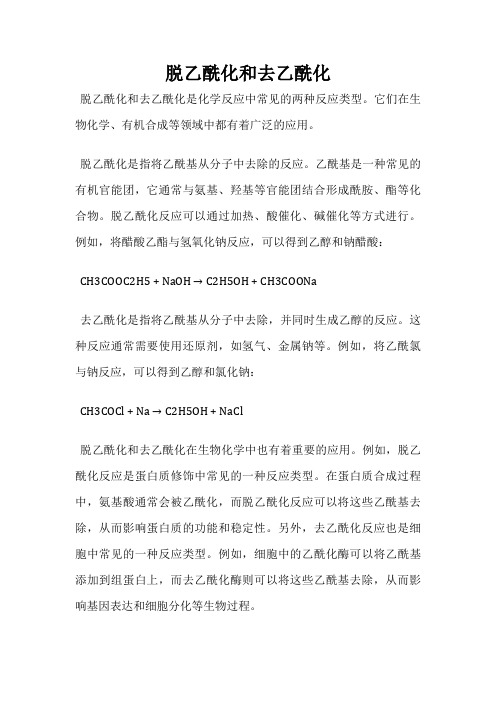
脱乙酰化和去乙酰化
脱乙酰化和去乙酰化是化学反应中常见的两种反应类型。
它们在生物化学、有机合成等领域中都有着广泛的应用。
脱乙酰化是指将乙酰基从分子中去除的反应。
乙酰基是一种常见的有机官能团,它通常与氨基、羟基等官能团结合形成酰胺、酯等化合物。
脱乙酰化反应可以通过加热、酸催化、碱催化等方式进行。
例如,将醋酸乙酯与氢氧化钠反应,可以得到乙醇和钠醋酸:
CH3COOC2H5 + NaOH → C2H5OH + CH3COONa
去乙酰化是指将乙酰基从分子中去除,并同时生成乙醇的反应。
这种反应通常需要使用还原剂,如氢气、金属钠等。
例如,将乙酰氯与钠反应,可以得到乙醇和氯化钠:
CH3COCl + Na → C2H5OH + NaCl
脱乙酰化和去乙酰化在生物化学中也有着重要的应用。
例如,脱乙酰化反应是蛋白质修饰中常见的一种反应类型。
在蛋白质合成过程中,氨基酸通常会被乙酰化,而脱乙酰化反应可以将这些乙酰基去除,从而影响蛋白质的功能和稳定性。
另外,去乙酰化反应也是细胞中常见的一种反应类型。
例如,细胞中的乙酰化酶可以将乙酰基添加到组蛋白上,而去乙酰化酶则可以将这些乙酰基去除,从而影响基因表达和细胞分化等生物过程。
脱乙酰化和去乙酰化是化学反应中常见的两种反应类型,它们在有机合成、生物化学等领域中都有着广泛的应用。
对于化学研究人员和生物学家来说,深入了解这些反应的机理和应用,将有助于推动相关领域的研究和发展。
乙酰化和去乙酰化修饰

乙酰化和去乙酰化修饰
乙酰化修饰通常发生在蛋白质的赖氨酸残基上,通过将乙酰基添加到赖氨酸上来改变蛋白质的电荷、构象和亲疏水性质。
这可以影响蛋白质的互作、局部结构和整体折叠状态。
乙酰化修饰也可以发生在DNA上,通过将乙酰基添加到组蛋白蛋白质上来影响DNA的紧密度和可读性,从而影响基因表达。
去乙酰化修饰则是通过去除蛋白质、DNA或RNA上的乙酰基来调节它们的功能。
这种修饰方式常常由去乙酰化酶催化,是维持细胞内化学平衡的重要机制。
例如,去乙酰化修饰可以改变某些DNA结合蛋白质与DNA的亲和力,从而影响染色质的结构和转录调控。
总之,乙酰化和去乙酰化修饰是细胞内非常重要的化学修饰方式,通过调节蛋白质、DNA或RNA的功能和稳定性,维持着细胞内的正常生理活动。
- 1 -。
组蛋白去乙酰化

组蛋白去乙酰化
乙酰化是多种有机体重要的信号传导过程之一,它可以促进细胞内蛋白质元件以及多只仓库中的蛋白质的功能表达,从而帮助调节该细胞的活动和发育期蛋白质的稳定性。
乙酰化是通过乙酰转移酶介导的,它们把乙酰基转移至从未乙酰过的蛋白质或者脯氨酸上,从而调节蛋白质的结构,细胞信号转导和其他的功能,乙酰化无疑是信号转导的重要环节,它能够发挥重要作用,有助于调节分子级别和细胞状态的变化。
乙酰化蛋白去乙酰化技术是一种能够反向地去乙酰化蛋白质的技术,它使用一种叫做乙酰羧化酶的酶辅助去乙酰化蛋白,此酶可以通过去乙酰化蛋白的羧基来失去乙酰基,或者它可以追踪乙酰蛋白的结构,从而提供有关乙酰化蛋白质的相关信息。
去乙酰化蛋白技术具有广泛的应用,它可以用于探索乙酰化蛋白的信号转导机制,可以用于分析和鉴定乙酰化蛋白质,也可以用于鉴定特定的乙酰蛋白,从而将其作为药物靶点。
此外,它还可以被用于检测乙酰蛋白质与细胞进化和发育,炎症反应以及免疫应答等相关联的调节因子。
综上所述,乙酰化是细胞的重要信号传递过程,去乙酰化蛋白技术被广泛用于探索蛋白乙酰化的信号转导机制,也可以用于分析和鉴定乙酰化蛋白质,有助于细胞进化发育和免疫应答等行为的调控。
它对细胞发育和机体功能具有十分重要的意义,也是未来研究和治疗疾病的热点与重点。
9-组蛋白(去)乙酰化

分子机制研究套路(九) 组蛋白(去)乙酰化课题:组蛋白乙酰转移酶 A 在B 基因转录调控中的作用1概念介绍:表观遗传学是研究基因的核苷酸序列不发生改变的情况下, 遗传学分支学科。
表观遗传的现象很多,主要包括DNA 甲基化、组蛋白修饰和非编码 RNA 。
染色质的基本组成单位是核小体,核小体是由 146bP 碱基对缠绕由H2A 、H2B 、H3、H4各组蛋白修饰指对组蛋白 N 端尾部氨基酸的修饰, 包括乙酰化、磷酸化、甲基化和泛素化等。
在组蛋白的各种修饰方式中, 组蛋白乙酰化的研究较为透彻。
组蛋白的乙酰化主要发生在赖 氨酸残基上,赖氨酸侧链含有氨基,在生理条件下带正电荷,从而能够和含有磷酸基团的DNA 紧密结合,被乙酰化后使得正电荷被中和,无法和 散,促进基因的表达。
组蛋白的乙酰化动态平衡由大量不同的组蛋白去乙酰转移酶 和组蛋白乙酰化酶(HAT )调节。
如前所述,组蛋白的乙酰化能够促进某些基因的激活,因 此通过使用HDAC 抑制剂相对提高组蛋白乙酰化的程度,能够显著上调大量具有保护作用古菌素A 、丁酸苯酯等。
早期,人们认为组蛋白修饰只是提供一个信号, 指导与染色体功能相关的非组蛋白与染色体 的结合。
随着研究的深入,人们越来越清楚地认识到这些修饰的某种组合对转录调控具有极基因表达了可遗传的变化的一门 2个组成的组蛋白八聚体构成的,各个核小体之间由H1连接,最终组成染色质。
DNA 紧密结合使得染色质结构松(HDAC )的基因,达到治疗某些疾病的目的。
目前临床使用的HDAC 抑制剂包括丙戊酸(VPA )、曲组蛋白或另一个组蛋白分子进一步修饰的决定因素, 特定的共价修饰,修饰发生的顺序特征以及各种修饰的组合模式形成了复杂的“组蛋白密码”,这种密码决定了基因的转录状态,其深刻的影响,“组蛋白修饰密码”假说诞生了。
这个假说推测特定的组蛋白修饰是同一个这种密码会被调控染色体结构和基因转录的蛋白质解读。
2.示意图:图1:组蛋白乙酰化的动态调节过程H3 M-莫孑TKOTAftTsTSa* lu>A T OOVK—匚目'・*1l ET H H ■'* *H4 3Gfi<;r<;GrCLGKG«Arjyift£VlJy?WI2eiTH2B Ns 「冃CF「; 4睛盯n,・rnn'lSl* Liltfiiikli«vLi tiF ' "( r I :[ . I I'll J ■ ri| .图2 :核心组蛋白八聚体的结构和组蛋白尾部可能的共价修饰3•研究思路: 3.1HDAC抑制剂使B基因mRNA上调,且使B基因启动子组蛋白H4乙酰化水平升高..33.2组蛋白乙酰转移酶A过表达增强B基因启动子的转录活性3.3B基因启动子上有A蛋白的结合,过表达A蛋白能升高细胞内源性B基因mRNA水平.4 3.4B基因启动子上的两个Sp1结合位点被确认3.5乙酰转移酶A和转录因子GATA-1协同激活B基因启动子转录,B基因启动子上两个I".ipf I.門、..GATA-1位点对于A的功能是必要的3.6乙酰转移酶A与转录因子GATA-1和Sp1协同增强B基因启动子的转录活性3.1 HDAC抑制剂使B基因mRNA上调,且使B基因启动子组蛋白H4乙酰化水平升高为弄清楚组蛋白乙酰化是否与B基因的转录调控有关,用HDAC抑制剂丁酸钠aBu和TSA处理cell-1细胞,培养24h后,进行RT-PCR分析。
- 1、下载文档前请自行甄别文档内容的完整性,平台不提供额外的编辑、内容补充、找答案等附加服务。
- 2、"仅部分预览"的文档,不可在线预览部分如存在完整性等问题,可反馈申请退款(可完整预览的文档不适用该条件!)。
- 3、如文档侵犯您的权益,请联系客服反馈,我们会尽快为您处理(人工客服工作时间:9:00-18:30)。
Characterization of the Yeast Trimeric-SASAcetyltransferase Complex*Received for publication,January7,2005Published,JBC Papers in Press,January18,2005,DOI10.1074/jbc.M500276200 Wei-Jong Shia‡§,Shigehiro Osada¶,Laurence Florens‡,Selene K.Swanson‡,Michael P.Washburn‡,and Jerry L.Workman‡ʈFrom the‡Stowers Institute for Medical Research,Kansas City,Missouri64110,the§Department of Biochemistry andMolecular Biology,The Pennsylvania State University,University Park,Pennsylvania16802-4500,and the¶Laboratory of Environmental Biochemistry,Graduate School of Pharmaceutical Sciences,Osaka University,1-6Yamada-Oka,Suita,Osaka565-0871,JapanThe yeast SAS2(Something About Silencing2)gene encodes a member of the MYST protein family of histone acetyltransferases(HATs)and is involved in transcrip-tional silencing at all silent loci(HML,HMR,telomeres, and rDNA)in Saccharomyces cerevisiae.Sas2is the cat-alytic subunit of a yeast histone acetyltransferase com-plex termed SAS complex.The enzymatic activity of SAS complex on free histones has been reported,but nucleo-somal HAT activity has not yet been documented.Here we show that the native yeast SAS complex is a small trimeric protein complex composed solely of Sas2,Sas4, and Sas5with a molecular mass of about125kDa.It is capable of acetylating both free histones and nucleo-somes,although the nucleosomal HAT activity of SAS complex is very weak when compared with that of NuA4, the other member of MYST HAT complex.We also dem-onstrate that the putative acetyl CoA binding motif in Sas2is essential for both the in vivo silencing function and the enzymatic activity of SAS complex.Unlike NuA4,which acetylates all four available lysines at the N-terminal tail of histone H4,SAS complex exclusively acetylates lysine16of histone H4in vitro and is required for the bulk of H4lysine16acetylation in vivo.This specific lysine preference corresponds to the role of SAS complex in antagonizing the spreading of Sir proteins at silent loci in S.cerevisiae.In eukaryotic nuclei,chromosomal DNA is packaged into a compact structure with histones to form chromatin.Chromatin can be an effective silencer of gene expression.Specifically, heterochromatin consists of highly condensed chromatin and is thought to contain primarily transcriptionally silenced genes. In yeast Saccharomyces cerevisiae,this type of transcriptional silencing occurs at several genomic locations including the HML and HMR mating-type loci,telomeres,and rDNA(1). Many proteins contribute to the establishment and mainte-nance of silenced chromatin.Among these proteins,Sir(silent information regulator)proteins1–4have been shown to play crucial roles at all silent loci(2).The Something About Silenc-ing2(SAS2)gene was first isolated in a genetic screen scoring for a mutant that can enhance the epigenetic silencing defects at HML in sir1⌬background(3).It has also been reported that SAS2regulates silencing differently at different loci.SAS2 functions as a positive regulator at HML and telomeres(3);its deletion leads to loss of silencing at these loci.Oppositely, deletion of SAS2enhances rDNA silencing(4)and restores the silencing defects at HMR with a mutated silencer(5).Notably, loss of SAS2does not affect silencing at wild-type HMR mating locus.The exact mechanisms for Sas2-mediated silencing at different loci remain unclear.Genetic evidence showed that two other genes,termed SAS4and SAS5,share the same regulatory functions in silencing with SAS2and may function in the same genetic pathway with SAS2(6,7).Sas2is a member of the MYST(MOZ,Ybf2/Sas3,Sas2,and TIP60)protein family of histone acetyltransferases(HATs).1 Proteins in this family include human MOZ(monocytic leuke-mia zinc finger protein),MORF(MOZ-related factor),TIP60, and HBO1,Drosophila MOF(males absent on the first),and Chm,and yeast Esa1,Sas2,and Sas3(8).The MYST-related proteins all share a highly conserved acetyl-CoA binding motif that is essential for their HAT enzymatic activities(9).Many members in the MYST family are found to be the catalytic subunit of a multiprotein HAT complex(Sas3p in NuA3and Esa1p in NuA4),and Sas2is no exception.Recent biochemical studies indicate that Sas2,Sas4,and Sas5exist as part of a 230–450kDa protein complex in yeast(4,10).Unlike Sas2, Sas4is unique in that it does not share homology to any known protein.Sas5,on the other hand,shares a conserved YEATS (Yaf9-ENL-AF9-Taf14-Sas5)domain with several proteins in-cluding human leukemogenic proteins AF9/ENL/Gas41,yeast Taf14,and Yaf9.Although the exact function of the YEATS domain is unknown,the YEATS triple knock-out yeast strain (yaf9⌬,taf14⌬,sas5⌬)is not viable(11),suggesting that the YEATS domain is essential for viability in S.cerevisiae.The predicted molecular masses of Sas2(39kDa),Sas4(55kDa), and Sas5(29kDa)add up to only123kDa,suggesting that the SAS complex may contain additional subunits that have not been identified.The yeast SAS complex,either native or recombinant,has intrinsic HAT activity on free histones(12),but nucleosomal HAT activity has not yet been reported.In studies with recom-binant SAS complex,it is clear that both Sas4and Sas5are required for optimal Sas2HAT activity.It has been demon-strated that mutations in the conserved acetyl-CoA binding domain of Sas2disrupt silencing at HML and telomeres(4,10)*This work is supported by NIGMS,National Institutes of Health Grant R37-GM-047867.The costs of publication of this article were defrayed in part by the payment of page charges.This article must therefore be hereby marked“advertisement”in accordance with18U.S.C.Section1734solely to indicate this fact.ʈTo whom correspondence should be addressed:Stowers Institute for Medical Research,1000E.50th Kansas City,MO64110.Tel.:816-926-4392;Fax:816-926-4692;E-mail:jlw@.1The abbreviations used are:HAT,histone acetyltransferase;TAP, tandem affinity purification;CBP,calmodulin-binding protein;Mud-PIT,multidimensional protein identification technology;WT,wild type; SWR,Swiz/Snf2-related.T HE J OURNAL OF B IOLOGICAL C HEMISTRY Vol.280,No.12,Issue of March25,pp.11987–11994,2005©2005by The American Society for Biochemistry and Molecular Biology,Inc.Printed in U.S.A. This paper is available on line at 11987and that the recombinant SAS complex with mutant Sas2loses its HAT activity (12).These results suggest a link between Sas2HAT activity and its regulatory roles in gene silencing.There is also a functional link between SAS complex and chro-matin deposition activity.The histone deposition proteins Asf1(anti-silencing function 1)and CAF-I (chromatin assembly fac-tor-I)both associate with the SAS complex (4,10,13).Asf1and CAF-I contribute to chromatin assembly by depositing newly synthesized histone H3and H4into nucleosomes (14–16).How SAS complex-mediated histone acetylation is involved in the chromatin assembly is unclear.It has been reported previously that a point mutation at lysine 16in the N-terminal tail of histone H4phenocopies the silencing effects caused by deletion of SAS2(4).This H4K16R mutation weakens the silencing at HML and telomere but enhances the silencing at rDNA and restores the silencing at the mutant HMR .We and others have shown that SAS complex is a histone H4lysine 16-specific histone acetyltransferase complex (12,17).The lysine preference of SAS complex plays a direct role in preventing the further spreading of Sir proteins into subtelomeric regions by antagonizing the deacetylation function of Sir2(17,18).The same anti-silencing function of SAS complex has also been observed at HMR silent locus,at which the SAS complex assists a unique tRNA Thr gene to establish a heterochromatic barrier (19,20).Together,these data suggest that SAS complex plays an important role in blocking the propagation of heterochromatin.In this report,we show that the native yeast SAS complex is a small trimeric protein complex consisting solely of Sas2,Sas4,and Sas5.Contrary to previous findings,we show that the molecular mass of SAS complex is about 125kDa.In addition,we demonstrate that SAS complex has novel in vitro nucleosomal HAT activity that is dependent on the acetyl CoA binding motif of Sas2.Unlike NuA4,SAS complex exclusively acetylates lysine 16of histone H4.All three subunits of the complex are required to maintain the overall levels of acetyla-tion at H4lysine 16in yeast cells.EXPERIMENTAL PROCEDURESYeast Strains and Plasmids—The genotypes of all strains used in this study are described in Table I.Chromosomal-tagged or deleted strains were generated by one-step PCR-based strategy as described previously (21,22).Standard yeast manipulations were performed as described (23).All knock-out strains were confirmed by PCR.The ex-pressions of tagged proteins were verified by Western blots.Plasmids for expression of galactose-induced Sas proteins (pS116,pS128,and pS129)were published previously (10).To make Sas2-TAP expression vectors,pRS426/TAP (pS223)was first made by subcloning a PCRfragment containing HindIII-TAP-SpeI into pRS426(pS23).Wild-type or mutant SAS2open reading frames with 1kb of upstream sequence were amplified by PCR from pS126,pS136,pS137,and pS138(10).The PCR products containing a SAS2gene with a 5ЈXhoI site and a 3ЈHindIII site were then subcloned into pRS426/TAP (pS223)to generate plasmids pS224to pS227.All plasmids generated were further verified by sequencing.Protein Expression and Purification—Whole cell extracts were pre-pared by following a previously published procedure (24).Purification of SAS complex (from YJW458,YJW475,and YJW476)and NuA4(from YWJS053)from a 12-liter culture by the tandem affinity purification method were essentially preformed as described elsewhere with minor changes (25).Whole cell extracts (5mg)and SAS complex (purified from a 4-liter culture)from YJW458were fractionated in a Superose 6HR10/30gel filtration column using A¨KTApurifier system (Amersham Biosciences)(10).TAP-purified SAS complex (purified from 2liters of YJW458)was also fractionated by 10–40%glycerol gradient sedimen-tation in TAP elution buffer at 300,000ϫg for 5h.SAS complex was loaded on a 4.5-ml gradient and collected in 100-l fractions.Gel filtra-tion calibration kits (Amersham Biosciences)were used to estimate the molecular weight of the protein complex.To check the overall in vivo histone H4acetylation level (see Figs.5A and 6A ),whole cell extracts were prepared as described (17).MudPIT—MudPIT mass spectrometry analyses were carried out as described previously (25–28).Immunoprecipitations,Western Blots,and Antibodies—For immuno-precipitations of Myc epitopes (see Fig.2),1mg of whole cell extracts from each strain were mixed with 1l of ␣-cMyc (clone 9E10,Roche Applied Science)at 4°C overnight.10l of washed,packed Protein G-Sepharose beads (Amersham Biosciences)were added to the mixture and incubated at 4°C for 2h.The beads were washed four times with the extraction buffer,eluted by boiling with SDS-PAGE loading buffer,and then run in 10%SDS-PAGE for Western blot analysis using per-oxidase-conjugated ␣-cMyc (clone 9E10,Roche Applied Science)and ␣-FLAG M2(Sigma).Fractions obtained from size exclusion chroma-tography and glycerol gradient centrifugation were assayed by Western blots using peroxidase-anti-peroxidase (Sigma),peroxidase-conjugated ␣-cMyc (clone 9E10,Roche Applied Science),and ␣-TAP (Open Biosys-tems).To check the overall in vivo acetylation level (see Figs.5A and 6A ),whole cell extracts corresponding to 1ϫ106cells were resolved in 18%SDS-PAGE and assayed by Western blots with ␣-3-phosphoglyc-erate kinase (Molecular Probes),␣-H4AcK5(Chemicon),␣-H4AcK8(Upstate),␣-H4AcK12(Upstate),and ␣-H4AcK16(Serotec).In Fig.6B ,HAT assay results were subjected to 18%SDS-PAGE and analyzed by Western blots with ␣-H4(Upstate),␣-H4AcK5,␣-H4AcK8,␣-H4AcK12,and ␣-H4AcK16.HAT Assays—For the experiments in Figs.4A ,5B ,and 6B ,HAT assays were performed in 15-l reactions at 30°C for 1h in the pres-ence of 40m M Tris-HCl (pH 8.0),0.1m M EDTA,10m M sodium butyrate,1m M phenylmethylsulfonyl fluoride,and 1.5M acetyl CoA (3H-labeled in Figs.4A and 5B ,non-radioactive in Fig.6B ).Substrates were as follows:1g of HeLa core histones,1g of HeLa nucleosomes,and 1g of recombinant yeast histone H4.For Figs.4A and 5B ,the procedure was as described (24).For Fig.6B ,the reactions were loaded on 18%T ABLE I Yeast strainsGenotypes of all yeast strains used in this study are shown.StrainGenotypeSourceYJW228a SAS4–13Myc:kanMX6Ref.10YJW274w303–1a ϩpESC/URA/6xHIS-SAS2-FLAGThis study YJW428a SAS2–13Myc :kanMX6ϩpESC/2/URA3/6HIS-SAS2-FLAG This study YJW458a SAS4–13Myc :kanMX6,SAS2-TAP :TRP1Ref.12YJW475a sas2-⌬1::TRP1ϩpRS426–2-URA/P SAS2SAS2WT-TAP This study YJW476a sas2-⌬1::TRP1ϩpRS426–2-URA/P SAS2SAS2M1-TAP This study YJW477a sas2-⌬1::TRP1ϩpRS426–2-URA/P SAS2SAS2M2-TAP This study YJW478a sas2-⌬1::TRP1ϩpRS426–2-URA/P SAS2SAS2M3-TAP This study YJW479a SAS4–13Myc :kanMX6ϩpESC/URA/6xHIS-SAS4-FLAG This study YJW480a SAS5–13Myc :kanMX6ϩpESC/URA/6xHIS-SAS5-FLAG This study YJW481w303–1a ϩpESC/URA/6xHIS-SAS4-FLAG This study YJW482w303–1a ϩpESC/URA/6xHIS-SAS5-FLAG This studyYWJS001BY4741MAT a his3⌬1leu2⌬0met15⌬0ura3⌬0Open Biosystems a YWJS002a sas2⌬:kanMX Open Biosystems a YWJS004a sas4⌬:kanMX Open Biosystems a YWJS005a sas5⌬:kanMXOpen Biosystems a YWJS053a ESA1-TAP :His3MX6Open Biosystems aaStrains were purchased from Open Biosystems.Trimeric SAS HAT Complex11988SDS-PAGE and assayed for acetylated histone H4by Western blots.For the experiments in Fig.4B ,nucleosome arrays were assembled using recombinant yeast histones (29)as histone sources and were used as substrates in HAT assays.Approximately 2pmol of SAS complexes were used in all HAT assays described above.RESULTSThe Native Yeast SAS Complex Is a 125-kDa Trimeric Com-plex—Many proteins in the MYST family of HATs are compo-nents of multiprotein complexes (30–32).In budding yeast S.cerevisiae ,two well studied examples from this family are Esa1in NuA4and Sas3in NuA3.We and others have previ-ously shown that Sas2,Sas4,and Sas5form the SAS histone acetyltransferase complex and that Sas2is the catalytic sub-unit (4,10,12).Size exclusion chromatography analysis indi-cated that the SAS complex was between 230–450kDa in size based on fractionation of whole cell extracts and complex purified from cells overexpressing Sas2.This molecular weight of the SAS complex,coupled with mass spectrometry analysis,suggested additional subunits besides the three known compo-nents.We were unable,however,to identify any bona fide additional subunits from the SAS complex purified from cells overexpressing Sas2.Thus,we sought to purify the native complex from cells with endogenous levels of Sas2.To purify the native and endogenously expressed SAS com-plex,we took advantage of the tandem affinity purification method (22).We generated a yeast strain with a TAP tag in SAS2and a Myc tag in SAS4.Both tags were integrated into the 3Јend of the gene of interest to ensure that expression was driven by the endogenous promoter.Yeast whole cell extracts were prepared from these double-tagged strains and subjectedto the two-step affinity purification procedure to isolate SAS complex.We then fractionated both whole cell extracts and TAP-purified SAS complex by Superose 6size exclusion chro-matography.Fractions were analyzed by Western blots probing for Sas2-TAP in whole cell extracts and Sas4-Myc in purified complex (Fig.1).In both cases,we observed one protein peak at fraction 16corresponding to 450kDa in size,suggesting that we did not disrupt the integrity of the SAS complex during the purification procedures.This result using native SAS complex is identical to our previously published findings (10)using overexpressed SAS complex.Therefore,it remained a possibil-ity that there were additional proteins in the complex besides Sas2,Sas4,and Sas5.To gain further insight into the detailed protein composition of SAS complex,we analyzed the TAP-purified SAS complex by MudPIT mass spectrometry analysis (Table II).A mock TAP purification from a yeast strain expressing Sas4-Myc was per-formed as a negative control.The three known subunits,Sas2,F IG .2.SAS complex is a trimeric protein complex.Yeast strains with or without chromosomal Myc-tagged SAS subunit were trans-formed with plasmid expressing FLAG-tagged SAS subunit (top ,YJW274,W303a ϩpSAS2-FLAG;YJW428,SAS2-Myc ϩpSAS2-FLAG;middle ,YJW481,W303a ϩpSAS4-FLAG;YJW479,SAS4-Myc ϩpSAS4-FLAG;bottom ,YJW482,W303a ϩpSAS5-FLAG;YJW480,SAS5-Myc ϩpSAS5-FLAG).Yeasts were grown in minimal medium with 2%galactose to induce the expression for FLAG-tagged subunit.Whole cell extracts were made,and 1mg of whole cell extracts were immunoprecipitated with ␣-Myc antibody followed by Western blots against either Myc-tagged or FLAG-tagged proteins (lanes 1and 4,5%input (In );lanes 2and 5,5%supernatant (Sup );lanes 3and 6,20%bead (Be )).Lanes 1–3serve as a negative control for Myc ne 6shows that no FLAG-tagged subunit can be pulled down by the same subunit with Myc tag.T ABLE II%coverage (spectrum count)SAS complex (SAS4-Myc,SAS2-TAP)Mock (SAS4-Myc)Molecular size ProteinkDa59.7(84)29Sas557.8(273)55Sas444.1(88)39Sas213.1(3)23Taf107.2(6)58Taf64.5(1)25Rpl103.5(3)72Plb13.1(3)82Ybr007c 2.9(1)31Bmh213.3(20) 5.2(5)94Mkt17.8(5) 2.6(1)50Rvb16.2(2) 3.1(1)52Gas55.3(2) 2.0(2)49Lsb34.4(2) 2.8(1)61Hsp602.1(1)1.4(1)100Pma1F IG .1.Gel filtration chromatography analysis suggests that the native yeast SAS complex is about 450kDa in size.The native yeast SAS complex was TAP-purified from the strain (YJW458)expressing both C-terminal Myc-tagged Sas4and TAP-tagged Sas2.Both whole cellextracts (WCE )and TAP-purified SAS complex were subjected to gel filtration chromatography on a Superose 6column using A¨KTApurifier system.All fractions were analyzed by Western blots probing for Sas2-TAP or Sas4-Myc.Molecular mass standards were used to estimate the size of the protein complex.Fr ,fraction.Trimeric SAS HAT Complex 11989Sas4,and Sas5,were identified as the top three proteins in MudPIT analysis based on the percent coverage and the num-ber of unique peptide hits.Additional proteins identified in the mass spectrometry analysis fell into two groups:those also found in the negative control sample and those found only in the purified SAS complex sample.Among the proteins that were recovered only from TAP-purified SAS complex,however,none had significant coverage or peptide hits (when compared with Sas2,Sas4,and Sas5)to suggest that they were bona fide components of the SAS complex.We also tested whether any of these proteins interact with the SAS complex in vivo by coim-munoprecipitation experiments;none of these proteins coim-munoprecipitated with the SAS complex (data not shown).Based on these findings,we conclude that Sas2,Sas4,and Sas5are the sole components of the SAS complex.These data pre-sented us with an interesting paradox since our size exclusion chromatography analysis indicated a 450-kDa complex,a num-ber that is not the additive molecular weights of Sas2,Sas4,and Sas5.One possible answer to this problem may be that the SAS complex contains multiple copies of one or more subunits.To test this hypothesis,we transformed a plasmid expressing Sas2-FLAG into a yeast strain with chromosomal-tagged SAS2-Myc .If there was more than one copy of Sas2in the SAS complex,coimmunoprecipitations from whole cell extracts with ␣-Myc antibody should be able to pull down FLAG-tagged Sas2.In fact,we were not able to detect any Sas2-FLAG signal in the ␣-Myc immunoprecipitation although the expression of Sas2-FLAG was robust (Fig.2,top panel ,lane 6).Myc immunopre-cipitations were determined to be efficient based on the fact that Sas2-Myc was dramatically reduced in supernatant (lane 5compared with Input lane 4)and enriched on the beads (lane 6).We performed the same experiments with Sas4and Sas5with similar results (Fig.2,middle and bottom panels ).As a negative control,immunoprecipitations were carried out in the absence of Myc-tagged SAS subunit (lanes 1–3).Reciprocal immunoprecipitations with ␣-FLAG were performed with the same outcome (data not shown).Collectively,these data indi-cate that the native yeast SAS complex is a trimeric protein complex consisting of single copies of Sas2,Sas4,and Sas5respectively.In gel filtration chromatography analysis,protein complexes will migrate according to their respective molecular weights only if they are globular.Therefore,this method should not be applied to determine the molecular weight of non-globular pro-teins.Accordingly,another possible explanation of our paradox is that the SAS complex forms a non-globular shape.To test this theory,we fractionated the SAS complex by glycerol gra-dient sedimentation,which separated proteins primarily on the basis of their mass and to a lesser extent on their density and shape (33).The SAS complex purified from the SAS2-TAP ,SAS4-Myc double-tagged strain was fractionated by 10–40%glycerol gradient sedimentation.Fractions were then analyzed by Western blots probing for Sas2-CBP and Sas4-Myc (Fig.3).The SAS complex signal peaked at fractions 9and 10in our analyses.After calibrating the fraction profile with molecular mass standards,we estimated that the native yeast SAS com-plex was actually 150kDa in size,approximately the sum of Sas2-CBP (44kDa),Sas4-Myc (75kDa),and Sas5(29kDa).If we subtract the contribution of the CBP (5kDa)and Myc (20kDa)tags from this value it indicates a molecular mass of the untagged complex of 125kDa,very near the sum of the pre-dicted molecular mass of Sas2,Sas4,and Sas5(123kDa).Therefore,we concluded that the SAS complex is a small (125kDa),trimeric (Sas2,Sas4,and Sas5)protein complex consist-ing of single copies of each subunit.SAS Complex Has Weak,but Real,Nucleosomal HAT Activ-ity—Several groups have suggested that the HAT activity of the SAS complex is responsible for counteracting the Sir2-mediated deacetylation at telomeres and HMR mating locus,thereby preventing the propagation of Sir proteins into euchro-matin (17–20).Thus,one possible function for the SAS complex in vivo is nucleosome acetylation.We had previously reported,however,that recombinant SAS complex was able to acetylate free histones but not nucleosomes in vitro .A very similar acetylation pattern was obtained when we tested the HAT activity of the native SAS complex (12).Although the HAT activity of the native SAS complex was above background,the results were not significant.Since those studies were pub-lished,we have optimized our in vitro HAT assays by adding histone deacetylase inhibitors,lowering salt content to 80m M total,and using more concentrated,TAP-purified SAS complex.These new conditions allowed us to detect significant SAS nucleosomal HAT activity for the first time (Fig.4A ,lane 5).Using similar amounts of histones,we found stronger SAS HAT activity on free histones when compared with that on nucleosomes (Fig.4A ,compare lanes 2and 5).We also com-pared the nucleosomal HAT activity of SAS complex to NuA4and found that even with an excessive amount of SAS complex (2pmol of SAS versus 0.1pmol of NuA4),nucleosomal HAT activity of SAS complex is still much weaker than NuA4(Fig.4,compare lanes 5and 6).To rule out the possibility that the SAS nucleosomal HAT activity was contributed by the contami-nated free histones in the reaction,we used immobilized nu-cleosomal arrays as substrates that allowed us to wash away any free histones in the reaction.Again,the nucleosomes were significantly acetylated by SAS complex (Fig.4B ).Therefore,we conclude that the native SAS complex has real,although weak,nucleosomal HAT activity.Members of the MYST family share a conserved acetyl CoA binding motif.Mutations at the acetyl CoA binding domain of Sas3cause the loss of HAT activity in NuA3(9).We have previously shown that the mutations in the Sas2acetyl CoA binding domain (M1,219GLG to AAA;M2,216QR to AA;M3,224LI to AA)resulted in the disruption of silencing at the telomere and the HML mating locus.Among those mutations tested,SAS2-M1mutation showed the most severe silencing defects (10).In addition,recombinant SAS complexcontainingF IG .3.SAS complex is a 125kDa,non-globular protein complex.SAS complex purified from YJW458(SAS4-Myc,SAS2-TAP )by the tandem affinity purification method was fractionated by 10–40%glycerol gradient centrifugation.Fractions were then assayed by Western blots against either Sas2-CBP or Sas4-Myc.Fractions not shown in this figure did not illustrate the presence of SAS complex.The molecular weight of the purified SAS complex was estimated based on the fractionation of molecular mass standards.IN ,input.Trimeric SAS HAT Complex11990Sas2-M1lost its ability to acetylate histones (12).It has been demonstrated that loss of SAS2will cause a dramatic reduction of in vivo acetylation at histone H4lysine 16(17).To further clarify the importance of the acetyl CoA binding domain of Sas2to its enzymatic activity,we checked the overall acetylation level at histone H4lysine 16in the presence of mutant SAS2and found that bulk H4lysine 16acetylation levels were indeed lowered in vivo (Fig.5A ).Next,we TAP-purified the native SAS complex with either wild-type SAS2or mutant SAS2(M1).The purification results were visualized by silver staining,and no difference could be observed between wild-type and mutant SAS complex (data not shown).However,the mutant SAS complex was no longer able to acetylate nucleosomes (Fig.5B ).We also obtained the same results using free histones as sub-strates (data not shown).Our data indicate that the acetyl CoA binding domain of SAS2is not only essential for its silencing function but also crucial for the HAT activity of the SAS com-plex.This result also confirms that the detected weak nucleo-somal HAT activity was indeed due to Sas2and not to any minor contaminants in thepreparation.F IG .4.SAS complex has weak,but real,nucleosomal HAT activity.A ,in vitro HAT assay using TAP-purified SAS (lanes 2and 5,from YJW458)and NuA4(lanes 3and 6,from YWJS053)as histone acetyltransferases,HeLa core histones (lane 1–3),and HeLa nucleosomes (lanes 4–6)as substrates.Half of the reactions were spotted on Whatman P-81filters for quantification.The other half was loaded on an 18%SDS-PAGE to separate individual histones.Gel was then stained with Coomassie Blue and subjected for fluorography.B ,immobilized nucleosome (Nuc.)arrays assembled from recombinant yeast histones were incubated with SAS complex.After stringent washing,acetylated nucleosomes were directly subjected for quantification by liquid counting assay.Data shown are the average of at least three separate experiments.Error bars represent standard deviation.Trimeric SAS HAT Complex 11991Histone H4Lysine 16Is the Exclusive Histone Substrate for the SAS Complex—We and others have shown that SAS com-plex specifically acetylates lysine 16of histone H4and that loss of SAS2is directly responsible for the reduction in overall acetylation level at histone H4lysine 16(12,17).Here we showed that SAS4and SAS5are also essential for maintaining the acetylation specifically at lysine 16of histone H4(Fig.6A ).Deletion of either subunit in the SAS complex caused the equal reduction of acetylation at histone H4lysine 16.Therefore,these results indicate that the SAS complex can function only if all three subunits are present.We next examined the in vitro substrate specificity of the native SAS complex by using yeast recombinant histone H4as acetylation substrate.The same experiments were also per-formed with NuA4as a comparison.The amount of SAS com-plex and NuA4used in the HAT assays were normalized based on the HAT activity obtained from a liquid counting assayusing 3H-labeled acetyl CoA.After the HAT reaction,we ana-lyzed the results by Western blots probing for various mono-acetylated H4isoforms (Fig.6B ).Unlike NuA4,which acety-lates all available lysines at the H4N-terminal tail,the native SAS complex exclusively acetylates lysine 16on H4.This result further demonstrates that the native SAS complex is an H4lysine 16-specific HAT complex that correlates with its anti-silencing function in antagonizing the Sir2-mediated deacety-lation of H4lysine 16.DISCUSSIONWe have presented evidence in this report that the yeast SAS complex is a small trimeric histone acetyltransferase complex that is capable of acetylating nucleosomes.Although the com-position of the SAS complex is simple (Sas2,Sas4,and Sas5),each subunit is vital for HAT activity both in vivo and in vitro .Sas2,as the catalytic subunit,is essential for theenzymaticF IG .5.Acetyl-CoA binding motif in Sas2is essential for the HAT activity of native SAS complex.A ,plasmid with wild-type or mutant SAS2-TAP was intro-duced into sas2⌬strain.Whole cell ex-tracts were probed with ␣-3-phosphoglyc-erate kinase (␣-PGK )as loading control and ␣-H4AcK16(lane 1,YJW475sas2⌬ϩpSAS2WT-TAP;lane 2,YJW476sas2⌬ϩpSAS2M1-TAP,219GLG to AAA;lane 3,YJW477sas2⌬ϩpSAS2M2-TAP,216QR to AA;lane 4,YJW478sas2⌬ϩpSAS2M3-TAP,224LI to AA).B ,SAS complexes were TAP-purified from either YJW475(wild-type)or YJW476(M1mutant).HAT activity of each complex was compared by HAT assay using HeLa nucleosomes as substrates (lane 1,nucleosomes alone;lane 2,nucleosomes with WT SAS;lane 3,nucleosomes with M1SAS).Results were analyzed by either liquid counting or fluorography.The amount of SAS com-plex used in HAT assays was normalized based on Western blot against Sas2-CBP.Data shown are the average of three sep-arate experiments.Error bars represent standard deviation.Trimeric SAS HAT Complex11992。
